8 Anatomy of Aircraft & Spacecraft
Introduction
Even to the layperson, it is evident that many different aircraft types comprise the aviation spectrum. However, most aircraft have common standard features, i.e., a fuselage, wings, tail surfaces, control surfaces, powerplant, undercarriage, etc. Larger aircraft will have more features, parts, and systems, and their airframe designs are commensurately more complex. To this end, aircraft types are placed into different categories and classes that relate to the relative complexity of their engineering design as well as their flight operations, e.g., the training and skill levels needed in their piloting and maintenance.
The U.S. Federal Aviation Administration (FAA), a division of the Department of Transportation (DoT), formally classifies aircraft according to categories, the primary categories being:
- Airplanes: Airplanes are engine-driven, fixed-wing, heavier-than-air aircraft that achieve flight through the reaction between the air and their wings, such as commercial airliners.
- Rotorcraft: Rotorcraft are aircraft that use rotating blades to generate lift, e.g., a helicopter or a tiltrotor.
- Lighter-than-air: Lighter-than-air aircraft fly using a lighter-than-air gas, e.g., a hot air balloon.
- Gliders: Gliders are designed to fly without an engine, e.g., a sailplane. An exception may be a self-launching motor glider.
- Powered Lift: These types of aircraft depend on engine-driven devices (e.g., propellers) or thrust (i.e., a jet engine) for lift at low airspeeds but non-rotating surfaces (i.e., wings) at higher airspeeds.
- Powered Parachute: These are aircraft comprised of a flexible or inflatable wing unsuitable for flight until the aircraft is in motion.
- Weight-Shift Control: These aircraft are only controllable in pitch and roll through the center of gravity changes, i.e., kinesthetic control.
- Rocket: A rocket is a flight vehicle propelled by expanding gases generated by an engine using self-contained propellants (i.e., rocket fuel.)
It is logical to expect that it will take more engineering effort to design the airframe and the many different systems used on a commercial airliner than for a glider. An airliner should also be held to a higher airworthiness standard because it carries many passengers. Spacecraft, however, are not classified in the manner done for aircraft, i.e., there are no officially designated categories or classes of spacecraft. Therefore, the name “spacecraft” can vary greatly depending on its mission, from simple probes to highly complex vehicles carrying astronauts. Furthermore, compared to aircraft, rockets and spacecraft have unique engineering challenges, such as dealing with the harsh environment of space and navigating in zero gravity, which require specialized skills and knowledge.
Learning Objectives
- Understand the essential parts of an airplane and their functions.
- Know the four fundamental forces involved in flight: lift, weight, thrust, and drag.
- Appreciate the functionality of flight controls on an airplane.
- Recognize the different types of wings, tails, undercarriage, and other components that can be used for airplane designs.
- Have a general appreciation for different types of spacecraft, including multi-stage rockets and satellites.
Anatomy of Flight Vehicles
Both aircraft and spacecraft must be designed for structural strength and lightness and will be comprised chiefly of shell-like monocoque or semi-monocoque structures. The overarching principle for all types of flight vehicle design is to use lightweight materials and minimal structure while ensuring adequate structural strength and flight performance in terms of payload and fuel-carrying capability, robustness, airframe durability, ease of maintenance and repair, etc.
Airplanes and spacecraft are designed and built from components comprising a series of assemblies and sub-assemblies, each usually having different functions. Still, the components must also be integrated to create a fully functioning flight vehicle. Component integration is a challenging aspect of all types of flight vehicle design, not just from a structural perspective; the engineers who do this work require broad multi-disciplinary skills and significant experience.
Airplane Anatomy
As shown in the figure below, for a relatively simple general aviation airplane, the airframe consists of five main groups of structural sub-assemblies, namely:
- The fuselage, i.e., the airplane’s main body, runs from nose to tail.
- The wings are the aerodynamically shaped structures designed to produce the lift on the airplane to overcome its weight.
- The empennage consists of horizontal and vertical stabilizers.
- The flight control surfaces, i.e., the ailerons, elevator, rudder, and flaps, which are controlled by the pilot.
- The undercarriage or landing gear allows the airplane to move around on the ground.
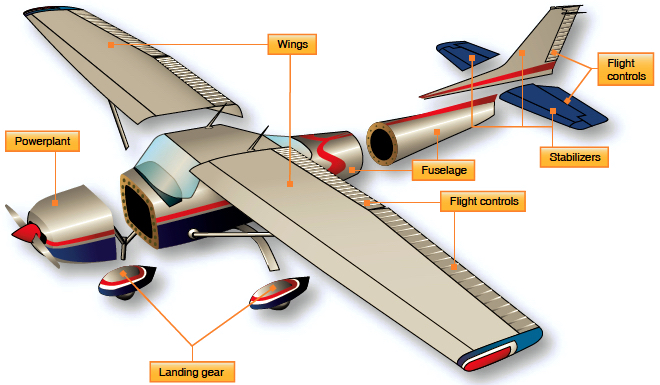
Each assembly must be designed for functionality and to carry the local loads imposed upon it and the loads transferred to and from each sub-assemblies. For example, the entire airframe and its components are joined using rivets, bolts, and other fasteners. In some cases, welding, adhesives, or other bonding techniques may be used instead of mechanical fasteners. The engine and propeller are other primary sub-assembles connected to the airframe before the airplane can fly. The engine is placed in a suitable mount and then connected through “hard points” (stronger areas of the airframe) to the remainder of the structure. Likewise, the landing gear must locally transfer high “point loads” into the fuselage structure.
Consider now the more detailed image below, in which the secondary components of the airplane are also identified. The wings (H & O) provide the primary lift force on the airplane to sustain its flight. The vertical stabilizer (B) gives the airplane directional (yaw) stability. The fuselage (A) is the main body of the airplane and houses the cockpit (J), engine (M), fuel, and various flight systems. The flaps (F & Q) allow the wings to sustain lift at low airspeeds and are used during takeoff and landing. The undercarriage (I & K) is the wheels used to maneuver the airplane on the ground – the main gear (I) and steerable nose gear (K). The propeller (L) provides the propulsive force to move the airplane forward; it is connected to the engine (M). The rudder (C) is used for directional (yaw) control. The ailerons (G & P) are differential flaps for roll control. The elevator (D) is used for pitch control. The horizontal stabilizer (E) gives the airplane stability in the pitch direction. The purpose of the wing struts (N), one for each wing, is to carry tensile loads to resist wing bending from the lift forces.
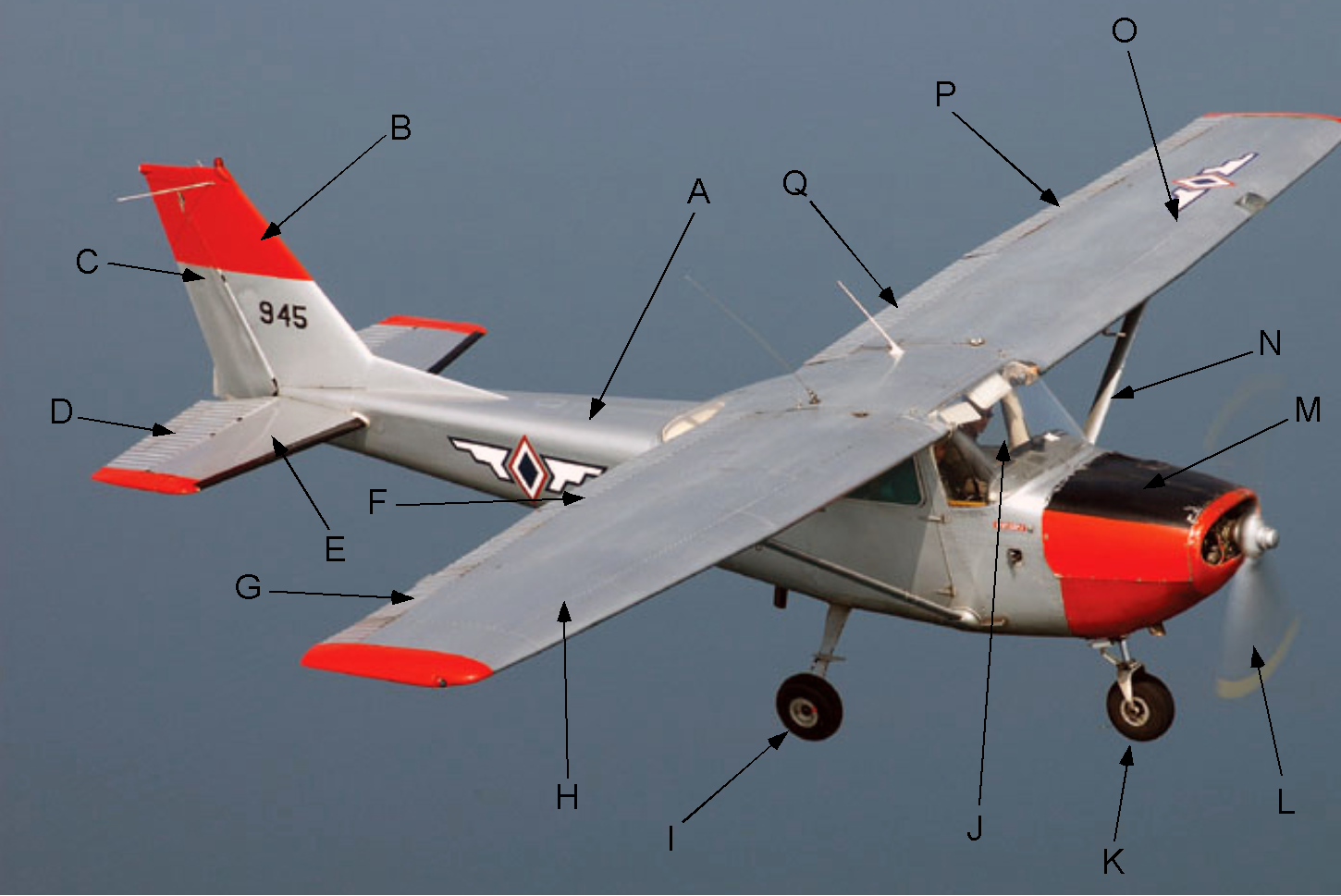
Larger and heavier airplanes have the same primary components but are usually multi-engined, so they have more complex airframe components and systems. For example, the diagram below shows a commercial airliner where the additional components used on this airplane include spoilers, leading-edge slats, multi-segment flaps, spoilers, multi-segmented control surfaces for low-speed and high-speed flight, and an all-flying trimmable horizontal stabilizer. The fuselage is designed primarily to accommodate passengers; it will also contain space for cargo and storage tanks for fuel. The wings will contain most of the fuel required for flight. The fuselage will be pressurized to create a comfortable environment for the passengers, which adds to the complexity of the airframe design and the needed systems, i.e., the fuselage becomes a pressure vessel.
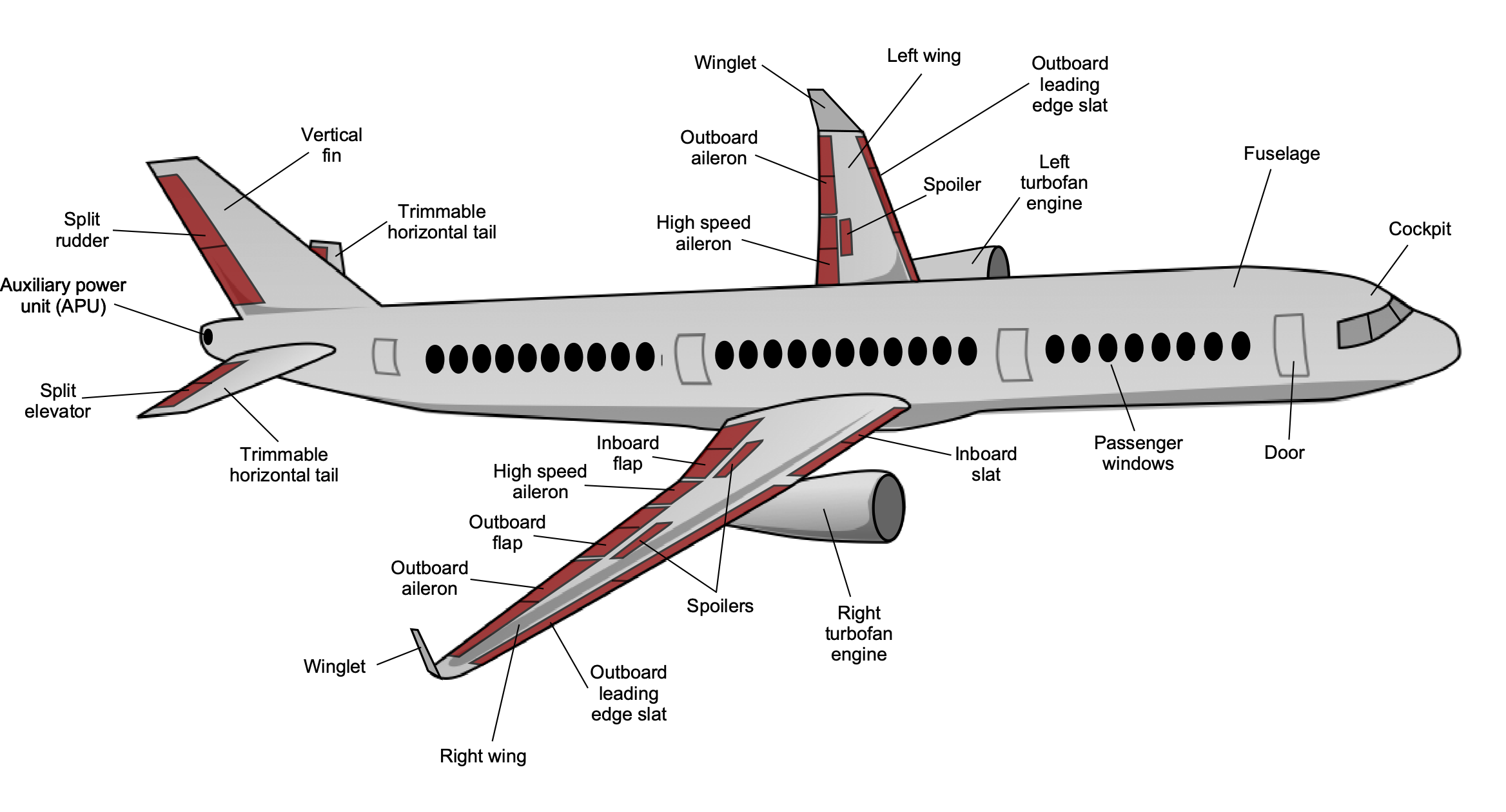
The structural weight of each component is also an important consideration, affecting manufacturing and operational costs. The weight of an airplane design generally grows disproportionately quickly with its increasing wingspan (i.e., the so-called “square-cube law“). For larger “jumbo” airliners, the detailed structural design becomes increasingly challenging to keep the airframe weight from becoming too heavy to the point that it limits the useful load-carrying capability of the airplane, i.e., the sum of the payload and fuel.
Wings
The primary function of the wings is to provide the needed lift to overcome the airplane’s weight. To create this lift, the wing shape is carefully designed so that the wings create the needed lift but also minimize the associated drag. The design of these components must balance conflicting requirements, such as lift, drag, stability, control, and structural efficiency, while also considering manufacturing and maintenance costs. Weight and drag are often regarded as the “killers” of aircraft performance, so low airframe weight and low aerodynamic drag are crucial to achieving good aircraft performance.
As illustrated in the figure below, wings are made of spanwise spars and stringers to carry shear forces and bending moments imposed by the aerodynamic lift loads, with crosswise ribs to give the wing its basic planform and cross-sectional shape. The ribs also carry torsion (i.e., twisting) loads. In addition, the wings may contain fuel tanks and other systems because they are mostly hollow, shell-type structures.
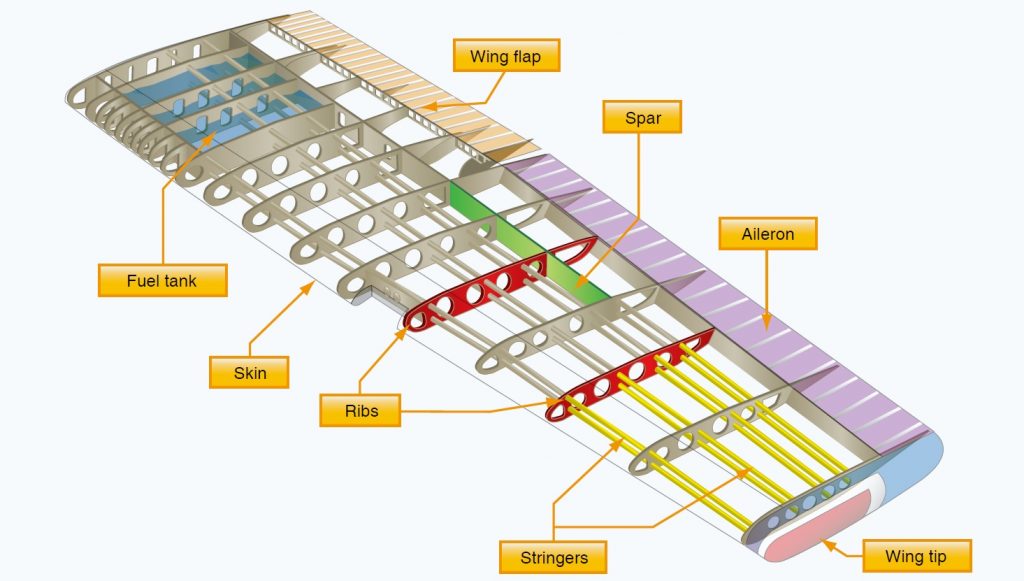
This internal wing structure is covered with a thin skin riveted to the internal structure. A rivet is an inexpensive and lightweight mechanical fastener that is bucked (i.e., deformed) into place, pinning the entire structure together. This type of airframe construction method is called a semi-monocoque stressed-skin design. Besides the ribs, the skin carries much of the torsion loads imposed on the airplane’s structure caused by the aerodynamic loads.
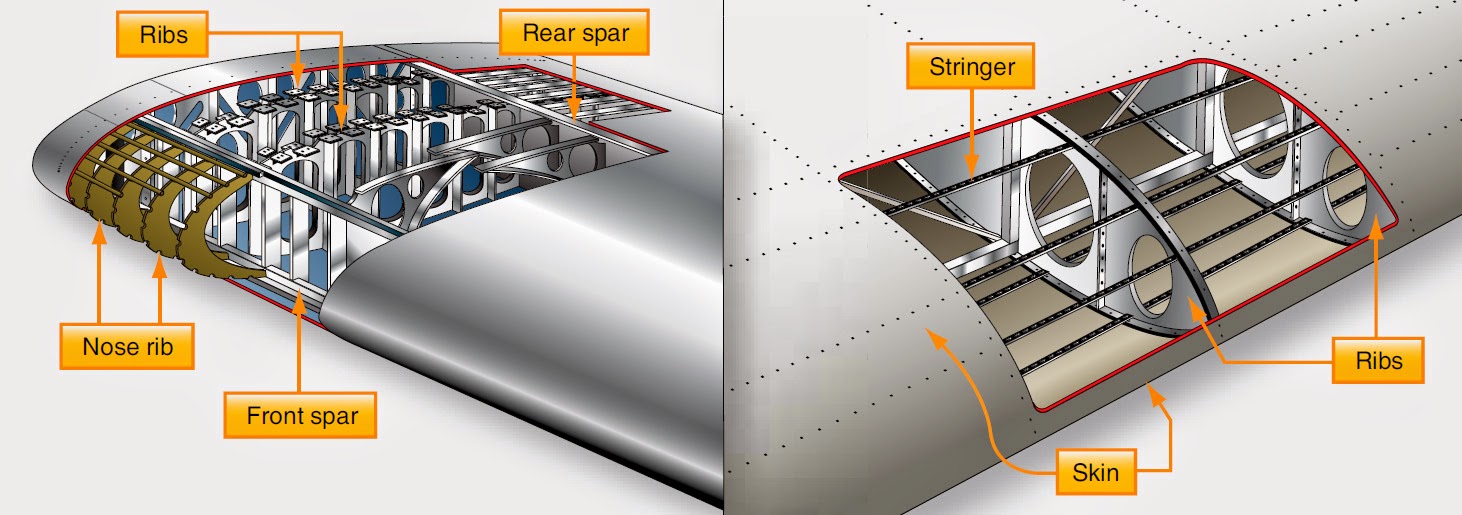
Like all aircraft structures, the wings are designed not only for aerodynamic functionality but also for lightness, strength, durability, and ease of maintenance. In addition, wings are designed and built to be extremely strong to ensure that they can carry the normally expected flight loads plus a generous safety margin and unexpected loads such as from gusts in the atmosphere, heavy landing loads, etc.
Cyclic loadings must also be considered as they may impact the weakening or fatigue of the metallic wing structure, i.e., the tendency to develop structural cracks or other related problems that can weaken the structure over thousands of flight cycles. To this end, regions of the structure that could cause high local stress concentrations and cracks should be minimized during the design. Needed openings such as passenger doors, cargo doors, and windows must be structurally reinforced, adding weight.
The durability and repairability of the structure are also important in that everyday use should not cause significant wear and tear or damage that requires frequent repair. However, if repairs are needed, they should be able to be readily performed at almost any airport without returning the aircraft to the factory. In this regard, metallic structures are readily repaired, although composite structure repair may require special facilities and tooling.
Empennage
The other aerodynamic lifting surfaces on the airplane are the horizontal and vertical tails, collectively known as the empennage. The empennage is a French word with its origin in the name for “tail feathers,” i.e., as related to the flights used for an arrow. The empennage may be conventional, or it may be in a “T” or an “H” configuration; a “V” tail is much less common.
The horizontal tail primarily gives the airplane stability in pitch in the horizontal plane, i.e., in the nose-up/nose-down direction about the pitch axis. This flight surface is called a horizontal stabilizer. In addition, the horizontal tail or stabilizer may be trimmable or “all-flying,” meaning that the entire lifting surface is mounted to pivot (pitch) nose-up or nose-down to create pitching moments to balance or trim the airplane in pitch. A trimmable tail also helps minimize flight drag and reduce the control forces.
The vertical tail gives the airplane directional or “weather-cock” stability, i.e., in the nose-left/nose-right direction in a vertical plane about the yaw axis, and is usually called a vertical stabilizer. Airplanes cannot fly without horizontal and vertical tails, although flying wings have been designed to blend the main wings with the functions of the empennage. Such “flying wings” use special aft-cambered reflexed airfoil sections to help balance the pitching moments on the airplane about its center of gravity.
Fuselage
The main body or fuselage of an airplane is primarily designed to carry the payload, i.e., the weight being carried that pays for the flight, which for a commercial airliner is the passengers and their luggage as well as any other cargo, as shown in the figure below. While most of the fuel is carried in the wings, there may also be fuel tanks in the fuselage under the main cabin floor or (in some airplanes) in the vertical tail. It should be remembered, however, that fuel is not a payload.
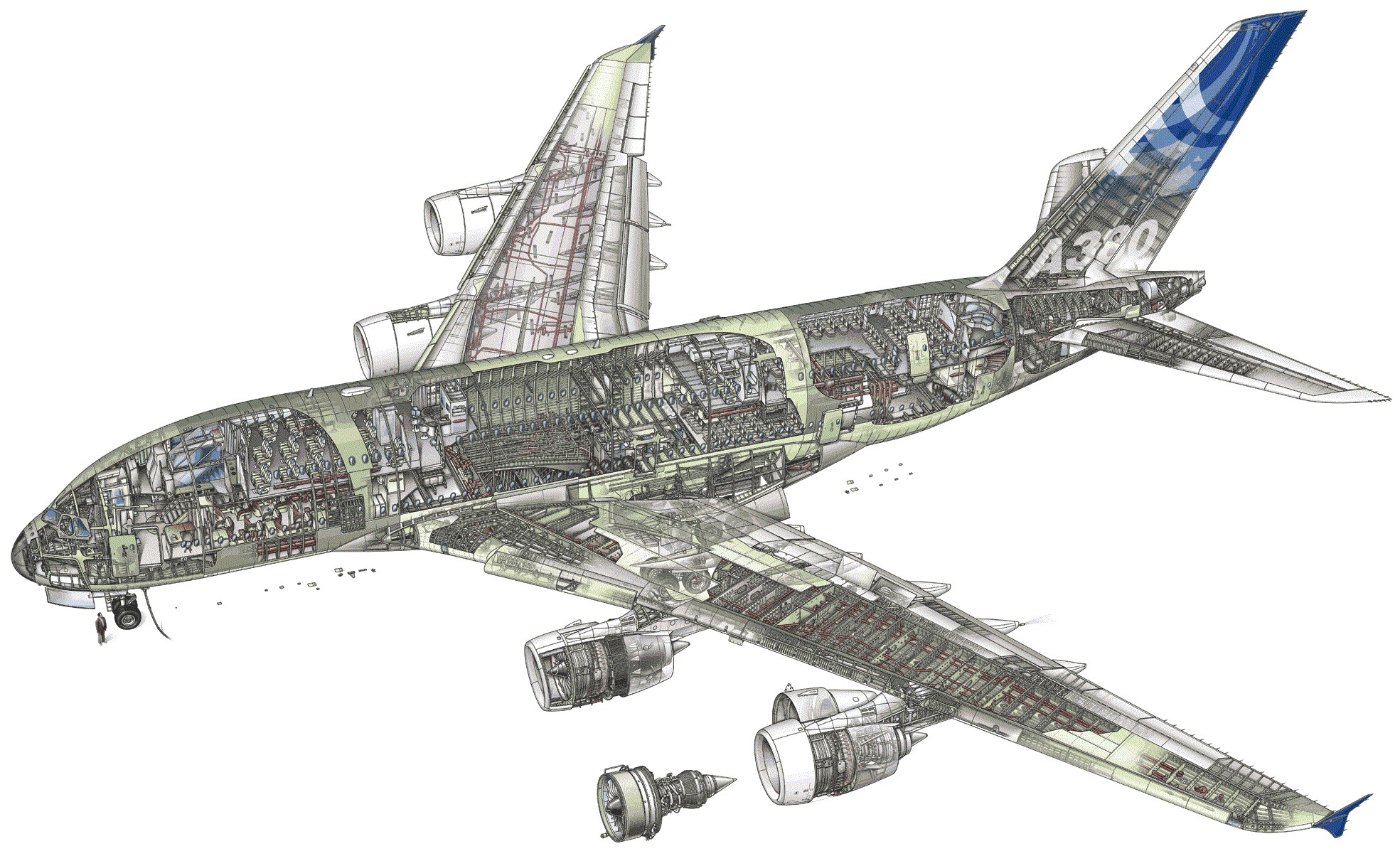
The shape of an airplane’s fuselage (length, cross-section, etc.) depends on many factors, including the number of passengers to be carried. Structural strength and weight considerations are also essential design factors besides the shape and form for good aerodynamic behavior, i.e., low drag.
On a commercial airliner, the fuselage is pressurized to an adequate internal pressure higher than the ambient outside air pressure when the airplane is at altitude, allowing the passengers to breathe normally as if they were closer to sea level, which keeps them comfortable. This means that the fuselage must be designed as a large pressure vessel from an engineering perspective, which imposes additional challenges and constraints in the structural design, especially from a weight perspective. Nevertheless, an unpressurized fuselage is not an option for an airliner.
Another important consideration in the aerodynamic design of the airframe is to keep any changes in cross-sectional shape relatively gradual, which reduces the tendency of the flow to separate from the surfaces, which will minimize drag. For an airliner, the shape of the airframe near the wing may also be subtly shaped in such a way as to reduce wave drag in cruise flight at transonic flow conditions (i.e., just below the speed of sound) where shock waves start to manifest.
As shown in the image below, the anatomy of a military fighter airplane is quite different from that of an airliner. Fighter airplanes are often required to fly supersonically, so the wings are thin and more delta-shaped with relatively short spans. The overall size and weight of the airplane must be minimized to give good airspeeds and maneuverability, which may impose extremely high loads on the structure. Instead of passengers, the airplane will carry a payload of various offensive and defensive weapons, including bombs and rockets. The design requirements may also call for ballistic protection of the cockpit area and critical aircraft systems.

A large part of the internal structure of a fighter airplane accommodates the engine (or engines) and the needed fuel. Jettisonable external fuel tanks are often used to extend the range and mission endurance because of the limited internal fuel tankage and the high fuel burn rates, especially when using the afterburners. Relatively large and aerodynamically powerful all-flying vertical and horizontal stabilizers are often used, which help give the airplane good maneuverability. Ballistic protection may also be needed for pilots and flight-critical systems, which can significantly add to the airplanes’ empty weight.
Engines & Powerplants
The engines on an airplane, often called powerplants, provide the propulsive force or the thrust to move the airplane through the air and overcome aerodynamic drag. On a modern commercial airliner, as shown in the photograph below, the engines produce large amounts of thrust. They have high propulsive efficiency with low specific fuel consumption, i.e., the fuel used per unit thrust. The engines also provide power for essential systems on the airplane, including hydraulic, pneumatic, and electrical, hence their more general designation as powerplants.
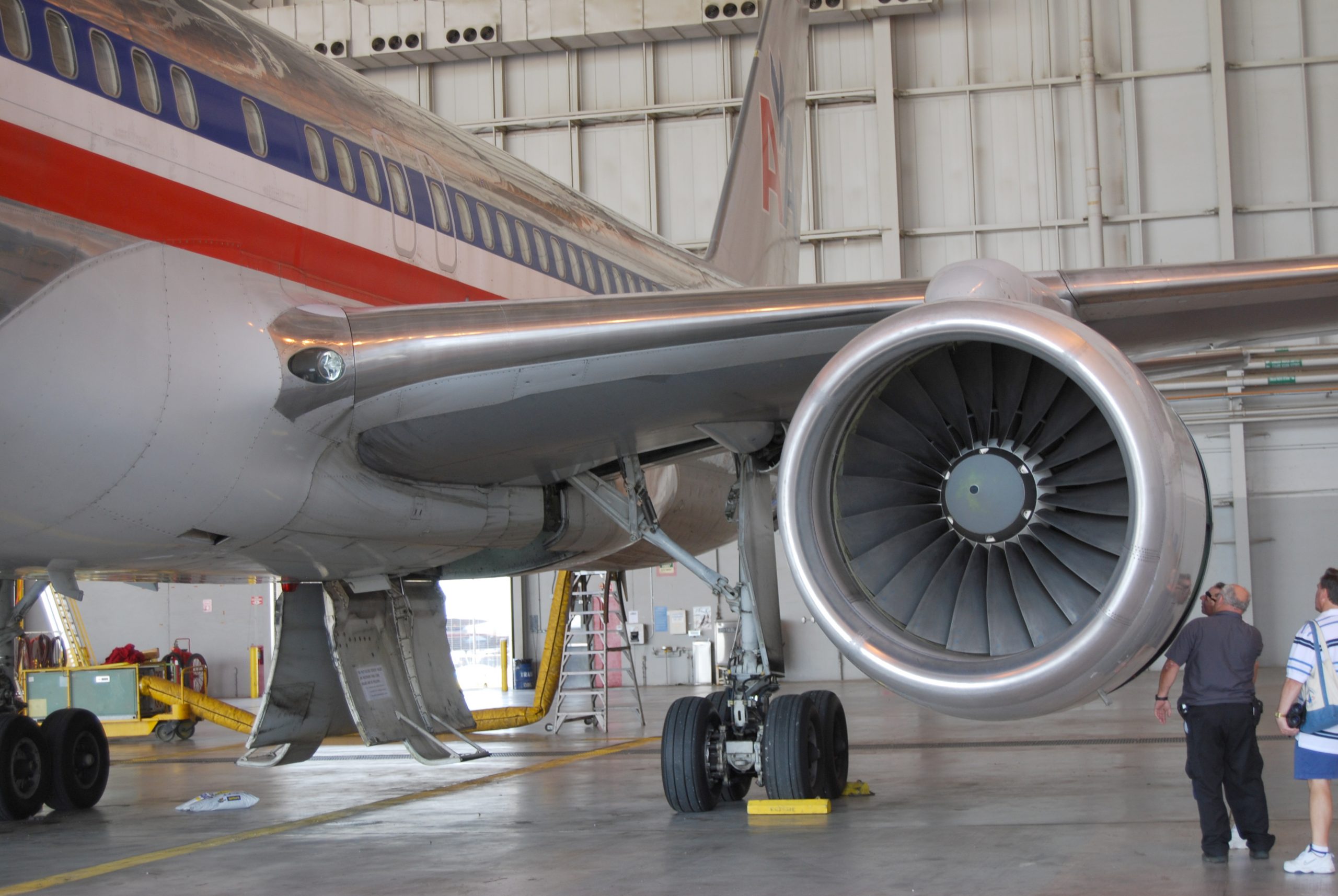
The principle of operation of a turbofan engine is shown in the figure below. The purpose of the fan is to accelerate a large mass of flow through the engine but with a relatively low change in flow velocity, so give a low exit or “jet” velocity. This particular approach increases the thrust-producing propulsive efficiency compared to, for example, a turbojet, where the thrust is produced by having a very high jet velocity out of the nozzle. The core of the engine drives the fan through a power turbine stage. In the core, the air entering the engine is compressed and then mixed with fuel and ignited; the hot gases then drive the power turbine. The jet velocity from the core is substantially higher than the bypass jet. However, the fan contributes to the majority of the thrust production.
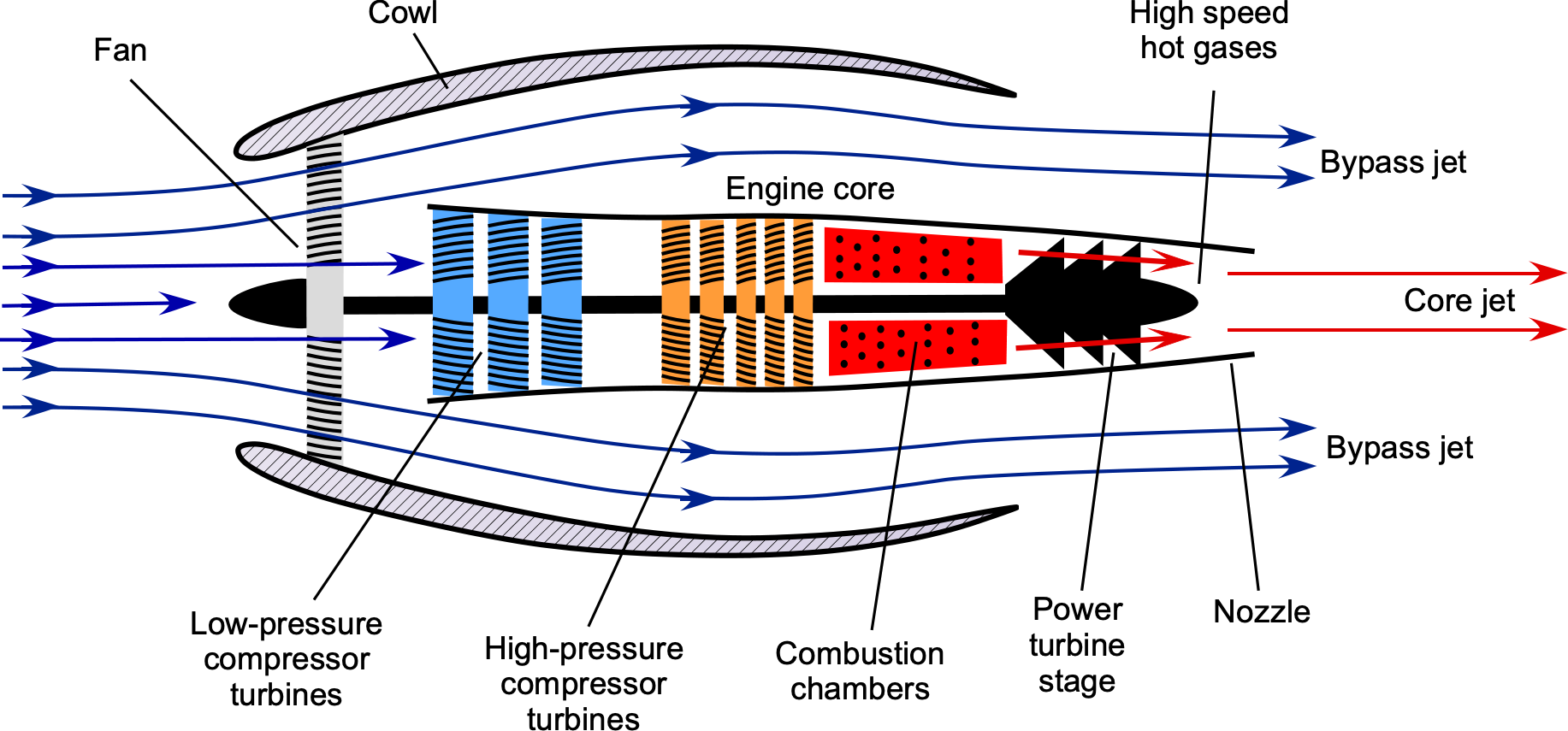
However, not all commercial airplanes are powered by turbofan engines, and turboshaft engines that drive propellers, i.e., turboprops, may power smaller commuter airplanes. Smaller airplanes (e.g., general aviation types) will usually be powered by piston engines, i.e., a reciprocating internal combustion engine driving a single propeller or perhaps in a twin-engine configuration. With few exceptions, helicopters will use one or more turboshaft engines.
An essential consideration in designing a multi-engine airplane is its ability to fly safely if one engine fails during its flight, called the One Engine Inoperative (OEI) flight. For a twin-engine airplane, each engine must be powerful enough to continue the flight, even though this reduces the airplane’s performance levels. Therefore, OEI flight performance is an important design consideration for all multi-engine airplanes. This aspect is scrutinized during flight testing and certification to prove that the airplane can still safely fly OEI.
Why a “plane” is not an “airplane”
The word “plane” is often used in the lexicon in reference to an airplane. However, engineers never use the name “plane” but always “airplane” (American English) or “aeroplane” (British English), or just “aircraft.” An aircraft can be anything that flies, but an airplane is a specific type of aircraft with wings that uses aerodynamic forces for flight. It is also helpful to recognize that the plural of aircraft is aircraft and never “aircrafts.” The word “aircraft” has an irregular plural, so it is both singular and plural. Likewise, we use “spacecraft” (singular and plural) and never “spacecrafts.”
Forces of Flight & Flight Axes
Before describing the flight controls and their effects on an airplane, it is essential to understand the forces of flight and the definition of the axes about which the airplane moves. Four forces act on an airplane, as shown in the figure below. First, the effects of “gravity” manifest as the airplane’s weight, given the symbol , which can be assumed to act downward at the center of gravity. The primary aerodynamic forces on the airplane are lift, given the symbol
, which is upward and in a direction opposite to the weight, and the drag
, which is parallel to the direction of flight.

The underpinning of flight is the lift on the wings, so understanding the aerodynamic characteristics of the wings is a vital part of airplane design. Lift generation results from the net pressure forces produced on the wing surfaces. As the airflow during flight approaches the wings, the flow is accelerated more over the upper surfaces, lowering the pressure relative to the pressure on the lower surfaces. Therefore, this pressure difference between the upper and lower wing surfaces is the source of the lift force that sustains flight. However, a consequence of lift generation is always drag.
In steady, unaccelerated, equilibrium flight, which is often called trim, the lift on the airplane will be equal to its weight, and the thrust required for flight will be equal to the airplane’s drag, i.e.,
(1)
and
(2)
The airplane can also pitch, roll, and yaw. It will pitch about the lateral axis, roll about the longitudinal axis, and yaw about the vertical axis, as shown in the figure below. In general, moments can be produced from the pilot’s application of the flight controls about each of the three flight axes, i.e., a pitching moment, , a rolling moment,
, and a yawing moment,
. The lift and drag can be assumed to act at a specific location on the wing called the center of pressure, where the pitching moment is zero; this position is often called the neutral point.
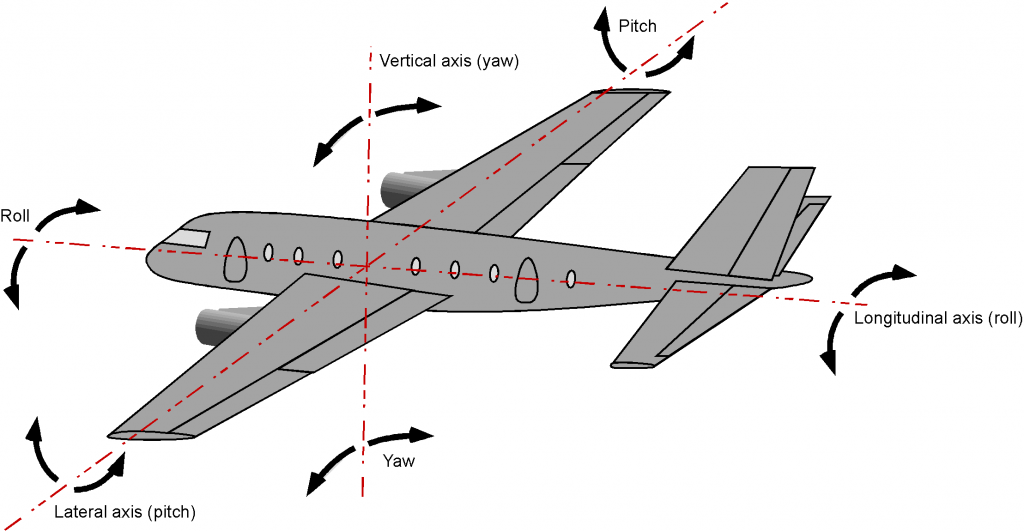
In steady-level equilibrium flight, i.e., in trim, the airplane’s net moments about its center of gravity must be zero, i.e.,
(3)
However, the need for force and moment equilibrium is not necessarily the case in maneuvering or accelerated flight.
Notice that the origin of the coordinate system that might be used for analysis can be at any convenient point; in engineering practice, different origin points may be used depending on the type of analysis being conducted. The airplane’s center of gravity is often used as a reference, although it should be remembered that the center of gravity is not a fixed point and will move somewhat during flight as fuel is burned off and the airplane’s weight decreases.
Consider, for example, the airplane in the figure below. The airplane’s weight can be assumed to act at its center of gravity. For vertical force equilibrium in trim, then
(4)
If the lift on the tail , where
would be less than 1, then
(5)
or
(6)
so
(7)
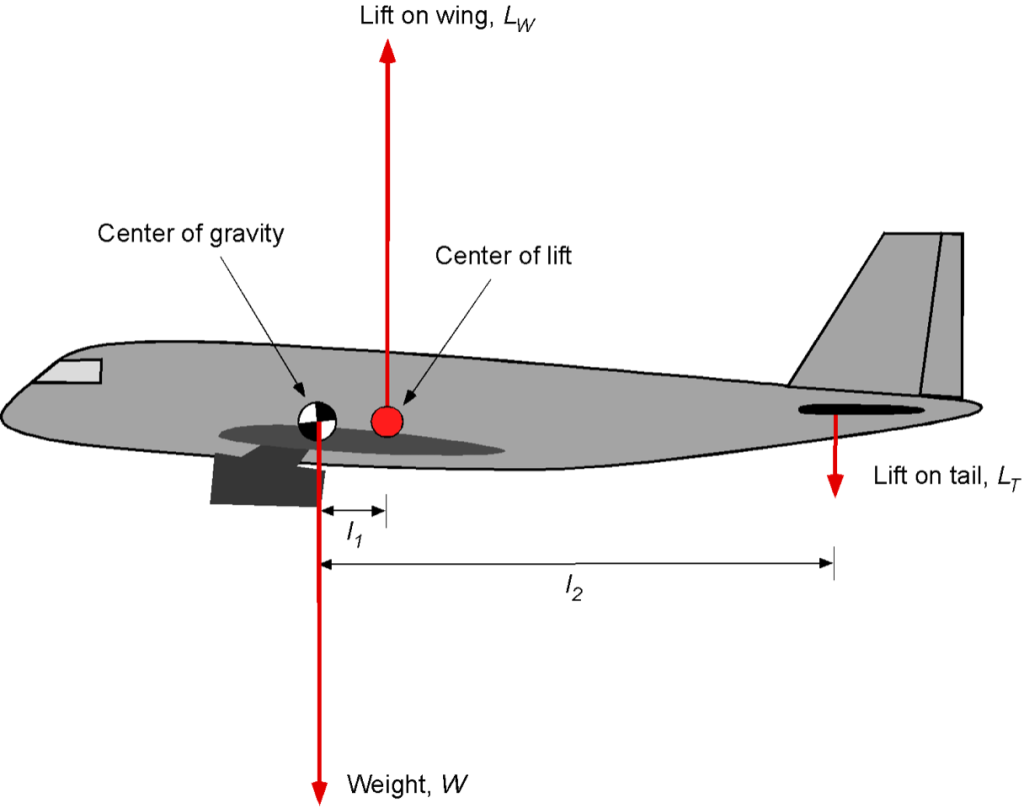
For pitching moment equilibrium in trim, then
(8)
so, in this case, then
(9)
Notice that as the value of increases, i.e., the center of gravity moves further away from the center of lift, then the downward force on the tail must increase, i.e., by applying the elevator controls or trimming the tail. There is a limit to how far this distance can be allowed to move, which is one reason constraining an airplane’s center of gravity envelope.
Flight Controls
The wings and empennage have flight control surfaces, i.e., the ailerons, elevators, and rudder, as shown in the figure below. The pilot controls the airplane’s flight to give it the desired flight attitude by simultaneously using the elevator, ailerons, and rudder. The skill required in the coordination of the flight controls must be learned. Each type of airplane can have somewhat different flight characteristics, but the basic functionality of the flight controls is the same.

The purpose of the ailerons is to give the airplane roll control about the longitudinal axis. As shown in the figure below, the ailerons are a set of differentially operated trailing edge wing flaps. When an aileron on one wing is deflected down, the other simultaneously deflects up, thereby producing a relative difference in the lift production on the two wings. The net result is a rolling moment in one direction or the other. Therefore, the ailerons control the angle of the airplane’s bank and help it turn.
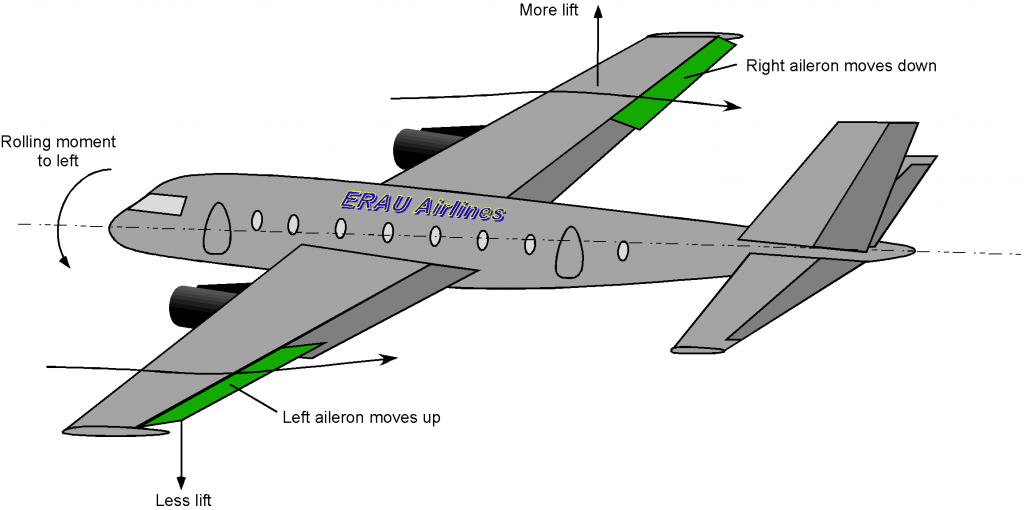
On some airplanes, particularly larger ones, there may be multiple sets of ailerons (or segmented ailerons), with one set near the wing tips and another inboard. The inner and outer sets of ailerons are used together at low flight speeds, such as takeoff and landing, to give the airplane better roll control, but only the inner sets of ailerons are needed in cruise. On modern airplanes, the phasing in and out of the appropriate sets of flight controls is all done automatically by the flight control system, i.e., the activation of the outboard and inboard segmented ailerons are phased in and out as a function of airspeed. This latter approach also helps minimize the wing’s structural bending and torsion loads associated with outboard control surface deflections at higher airspeeds.
The horizontal and vertical tails also have trailing edge flaps. On the horizontal tail, they are called the elevators, and on the vertical tail, it is called the rudder. Deflecting the elevators up and down (both sides of the elevator move together), as shown in the figure below, the relative lift on the horizontal tail is increased or decreased. The primary effect is changing the airplane’s pitching moment about its center of gravity. Therefore, the pilot’s use of the elevator controls the airplane’s pitch attitude. The function of the trimmable tail has already been discussed.
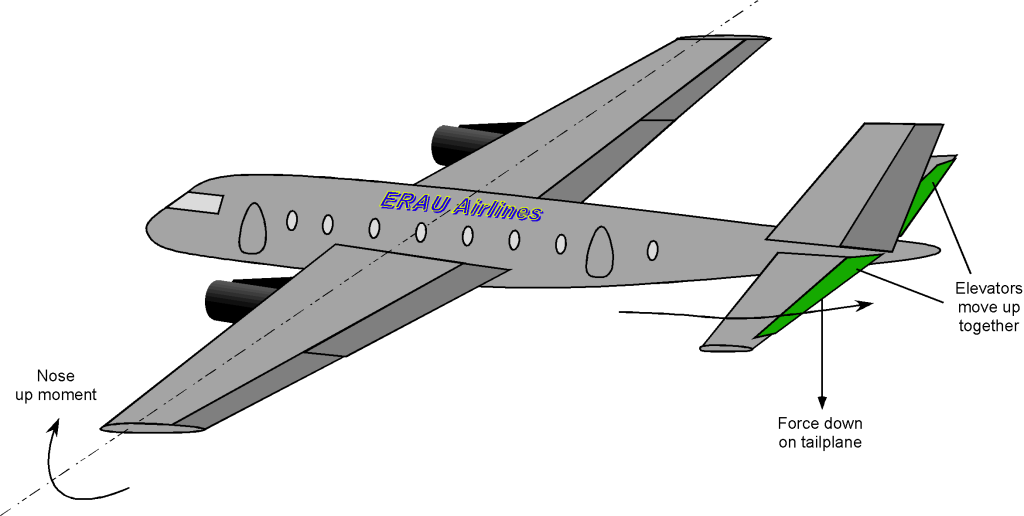
Similarly, deflecting the rudder left or right produces a yawing moment, i.e., the rudder deflection produces a nose-left or nose-right response, depending on the direction of angular deflection, as shown in the figure below. Like the ailerons, the elevator and the rudder may have segmented sections, especially on larger airplanes, the activation of which is phased in or out as a function of airspeed.
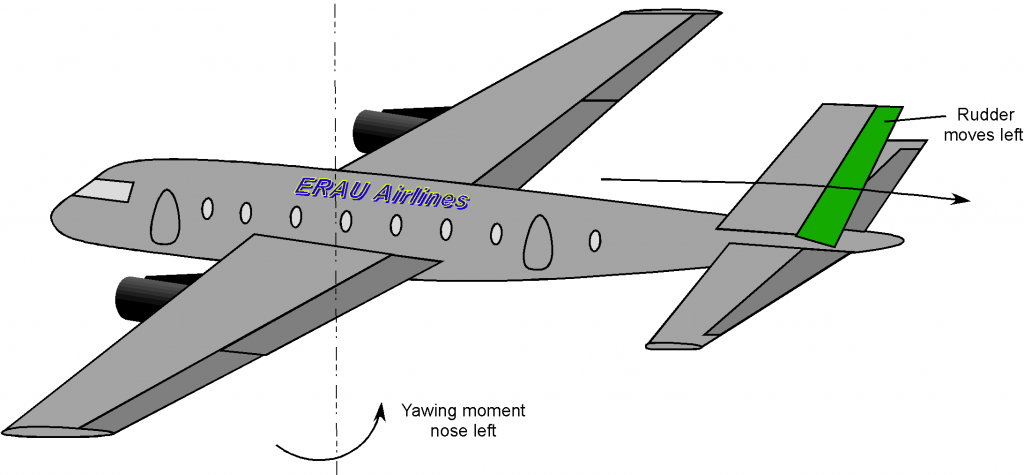
Flaps & Slats
The flaps and slats on a wing allow the airplane to fly at lower airspeeds without stalling and losing lift, so they are primarily used during takeoff and landing. Flaps and slats are called high-lift devices. As airspeed is reduced, the wing must operate at an increasingly higher angle of attack, which the onset of stall will eventually limit lift production. Wings operate successfully without stalling only at low angles of attack to the flow. However, the deflection of the flaps and possibly slats, as shown in the figure below, allows the airplane to fly at lower airspeeds without stalling, commensurately reducing the takeoff and landing distances.
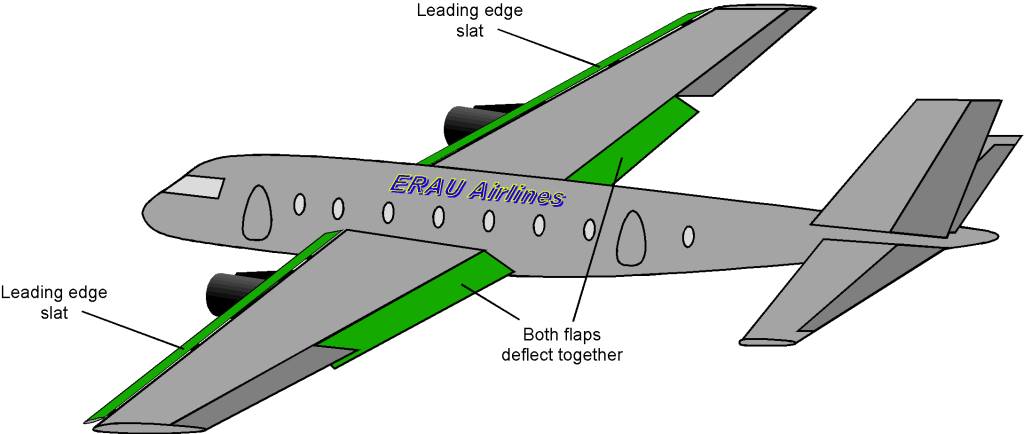
The wing shape of a commercial airliner is primarily designed for efficient aerodynamic flight at higher (transonic) airspeeds and higher altitudes, so this relatively thin wing shape tends not to function as well at low airspeeds. For this reason, flaps and slats are used for takeoff and landing. High-lift devices are critical for larger airplanes operating at high gross weights to keep takeoff and landing distances down to match the available runway lengths.
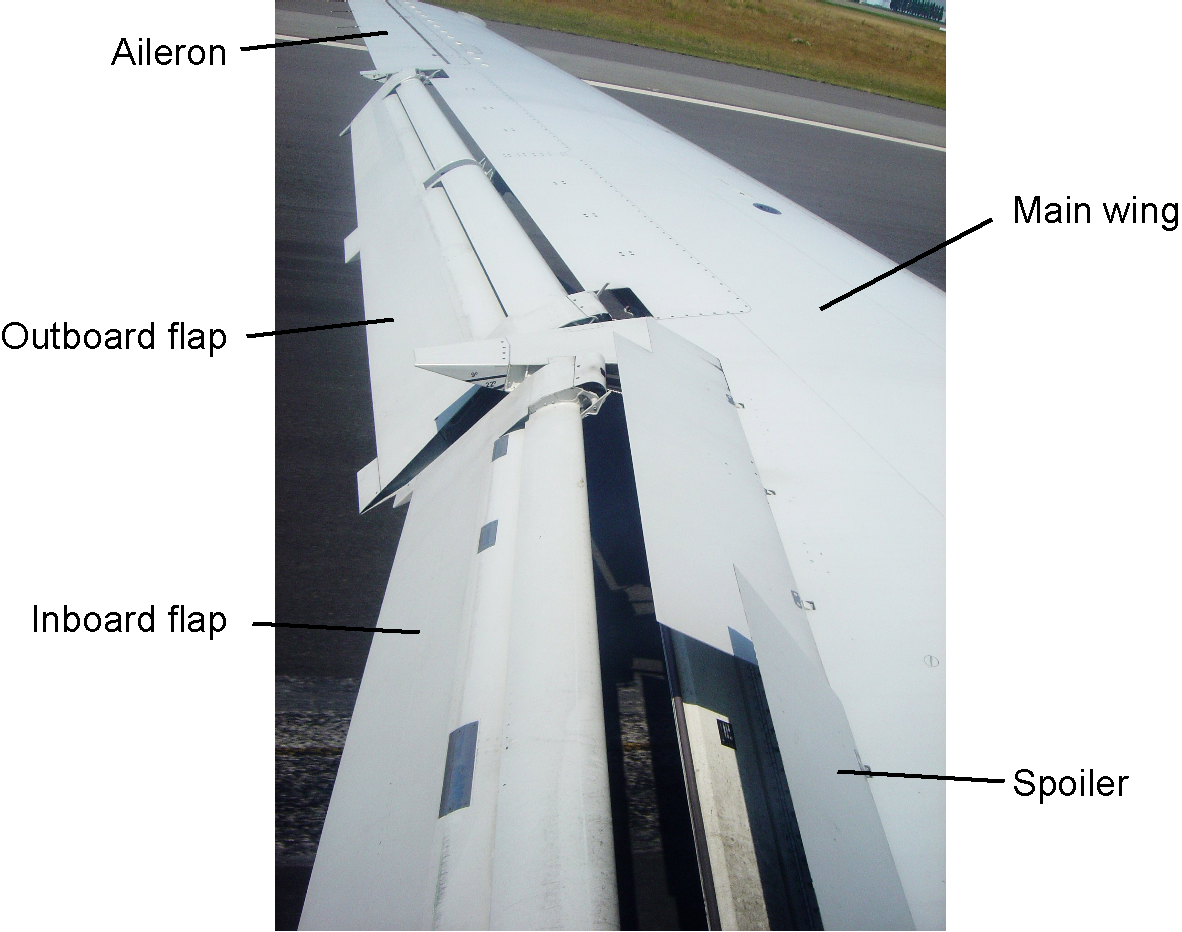
The flaps are often designed to deflect downward and rearward, as shown in the figure below, increasing the wing’s effective area as well as its curvature or camber. The net effect is that the wing can now operate at a lower airspeed without a tendency to stall, although the drag on the wing also increases with the flap deflection angles. The application of large flap deflections creates much drag and usually requires that the pilot apply extra thrust to maintain level flight at the same airspeed.

Flap systems may have secondary elements (e.g., double-slotted or triple-slotted flaps), which are designed to deploy progressively in stages, as shown in the figure below. The flaps are partly extended and deflected to reduce the takeoff airspeed and distance. The airplane quickly needs to build up airspeed and does not need the high drag associated with full flap deflection. After takeoff, the flaps on the airplane are progressively retracted as its airspeed builds. A great animation of a triple-slotted flap system can be found here.
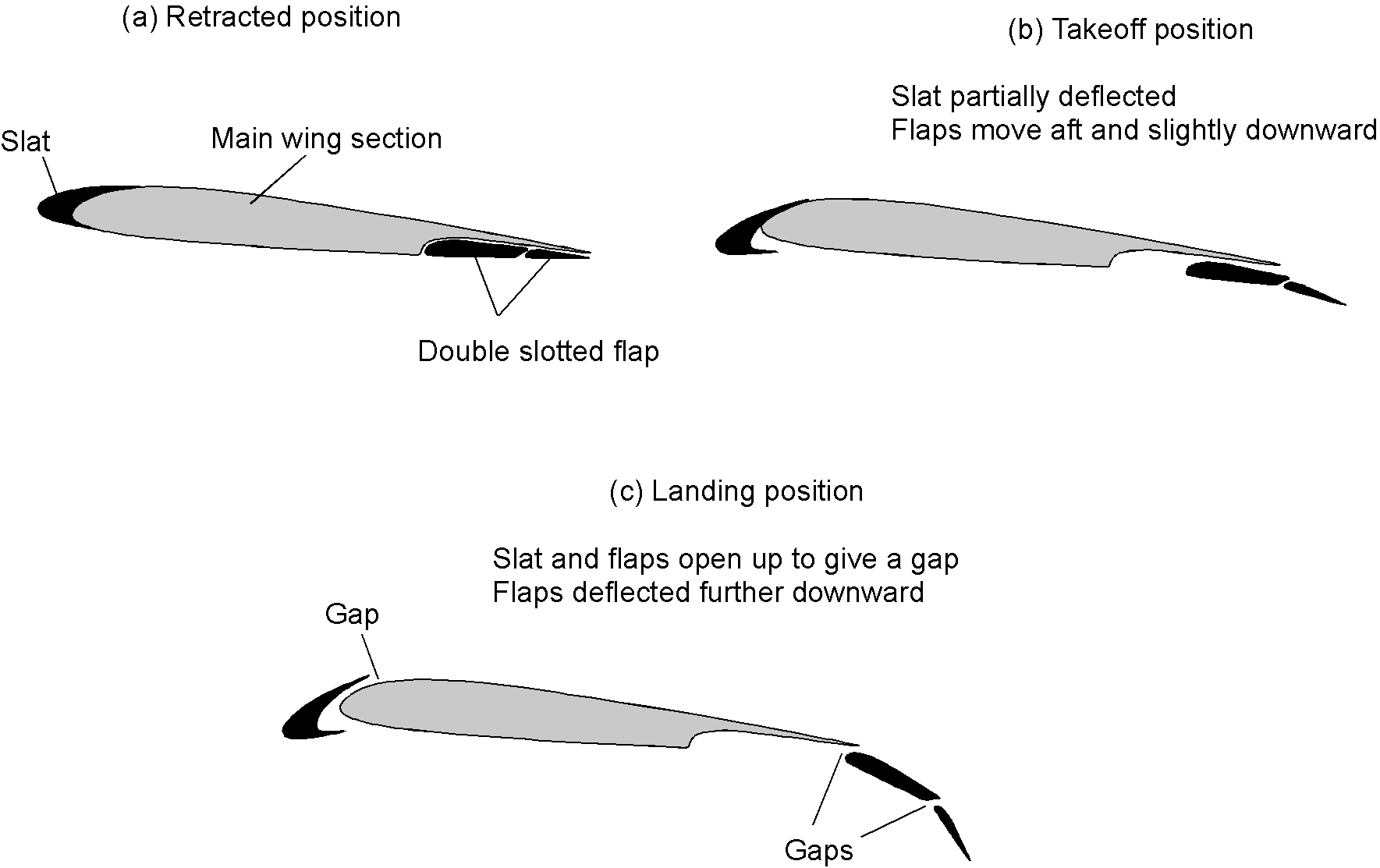
For landing, the flaps will eventually be fully deflected; the pilot extends them progressively in stages as the airplane descends from altitude and slows down to its final landing approach speed. The extra drag from full flap deflection helps slow the airplane down to acceptable landing airspeeds; this steepens its final approach angle to the runway, allowing the pilot to control the flight path and the flight rate of descent of the airplane during the landing approach.
The leading-edge slats also work in synchronization with the flaps, and like the trailing-edge flaps, their purpose is to delay the onset of stall, allowing the airplane to fly at lower airspeeds. The slats initially move forward and downward to increase the camber of the wing section and, when fully deployed, open up a small gap between the slat and the leading edge of the main wing. This gap between the flap segments is critical and helps to keep the flow attached over the flap surfaces at higher flap deflection angles.
Slats are highly effective in delaying the onset of a stall on a wing and creating more lift, although, like the flaps, they also increase drag somewhat and may change the center of lift on the wing and create a pitching moment on the airplane. For this latter reason, the slats and flaps are usually activated simultaneously to minimize any changes in pitching moments, with partway deflections being used for takeoffs and full deflections for landings. With both fully deployed slats and flaps, the airplane can typically fly at airspeeds that may be nearly half of what it would be without them, i.e., compared to flying in the “clean” condition with flaps and slats retracted.
Specific Flap Designs
As summarized in the figure below, there are many different trailing edge flap designs, each with advantages and disadvantages. Among the standard designs are plain flaps, which offer simplicity and moderate lift augmentation but with limited effectiveness at low airspeeds. Split flaps provide greater lift but at the cost of increased drag, while slotted flaps overcome some of these limitations by preventing flow separation and generating higher lift coefficients. Fowler flaps are renowned for their significant lift augmentation and drag reduction, but come with added weight because of their more mechanically complex deployment mechanism. Junkers flaps offer substantial lift augmentation, but the external drag of the supporting mechanical structure is a concern. Gurney flaps provide a simple modification for lift enhancement and stall delay, albeit with limited effectiveness compared to other designs.

In selecting a flap design, designers must carefully balance lift augmentation, drag reduction, complexity, weight, and cost. While some designs prioritize simplicity and lightweight construction, others prioritize significant lift enhancement and drag reduction, albeit with increased complexity and maintenance requirements. The choice of flap design ultimately depends on the aircraft’s specific performance requirements and operational envelope.
Main Wing Designs
Airplanes come in many shapes and sizes, with various combinations of main wings, tails, and undercarriage configurations. Even a cursory look at the early history of aviation will show nearly as many different wing and tail configurations as airplane designs. As shown in the figure below, examples of main wings include high-mounted, low-mounted, mid-wings, gull, etc., and various types of swept wings.

Wings can also have different planform shapes (i.e., the outline shape of the wing when viewed from above), such as rectangular, tapered, elliptical, or some other variation. Naturally, there are sound engineering reasons (in most cases) for preferring one wing shape over another. Swept wings are designed for high-speed flight, and the sweepback helps to alleviate compressibility effects and reduce drag, allowing the airplane to fly faster. However, sweeping back a wing does create other engineering concerns, so the sweepback is usually kept to a minimum. In addition, using forward-swept wings is unusual because of their susceptibility to undesirable aeroelastic effects.
Wings can also be cantilevered (i.e., no external bracing with all internal structure), braced with struts and wires, and appear as monoplanes (single wings), biplanes, and even triplane configurations, as shown in the figure below. The cantilever monoplane design is the most common wing for airplanes because of its low aerodynamic drag. However, lower-performance airplanes may use braced wings because of their comparative lightness compared to an entire cantilevered wing.
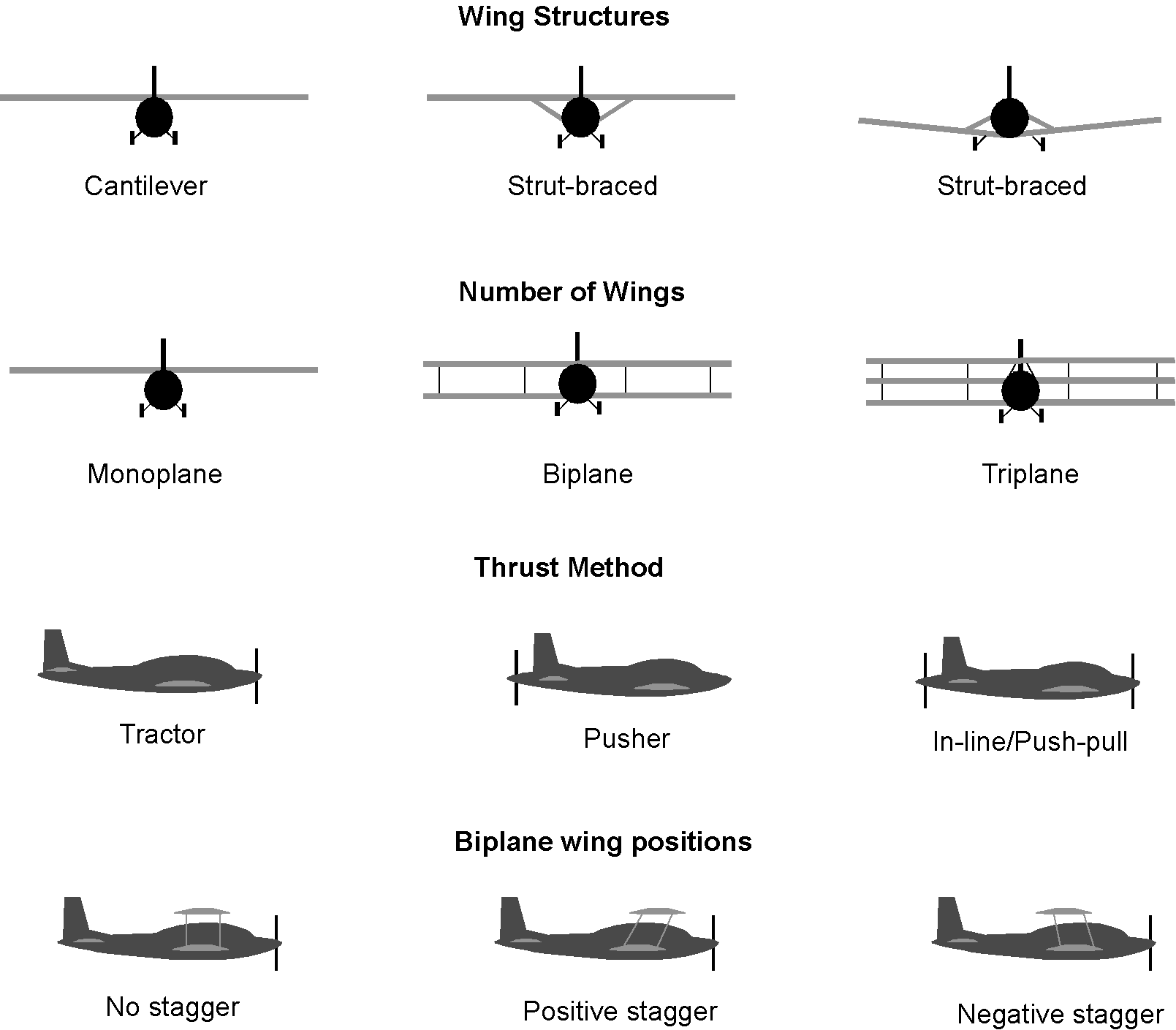
In the early days of aviation, wings were built as biplanes or triplanes, which gave the wood and fabric wing structures the needed bending and torsional strength and stiffness. However, the high aerodynamic drag of the struts and wire bracing between the wings significantly reduced the airplane’s performance, especially limiting its maximum achievable airspeeds.
The advent of aluminum alloys as a construction material soon allowed “stressed-skin” monoplanes to be built, which gave the wing much strength and significantly less drag. As a result, monoplane airplanes could soon fly at much higher airspeeds. However, a problem with early monoplane wings was flutter, an aeroelastic phenomenon that can lead to a catastrophic structural failure of the wing. Designers soon learned about the flutter problem and established design techniques to give wings the needed structural stiffness to avoid flutter.
At the tips of a wing, the flow leaks around the edges and develops into a swirling flow called a wing tip vortex, a source of drag called induced drag. The detailed shape of the wing tips influences the roll-up of the tip vortices. Over the decades, many different wing tip shapes have been designed to reduce the induced drag, as shown in the figure below. One of the most common designs today is the winglet, which has been proven to reduce drag on commercial airplanes and give significant fuel savings over the airplane’s operational life.
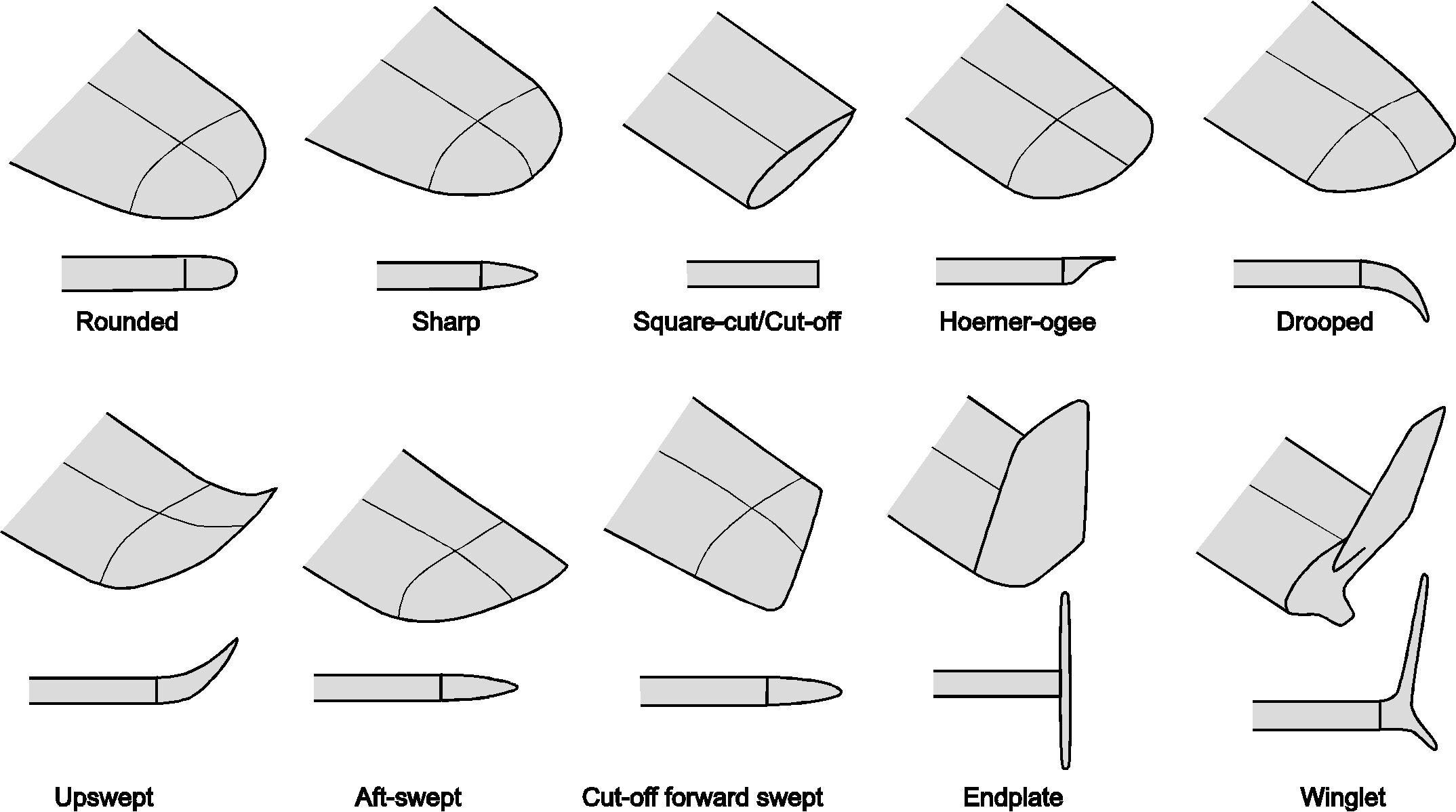
Tail or Empennage Designs
The tail section or empennage of an airplane can also take on different configurations, including the conventional or “standard” tail with horizontal and vertical surfaces, but also “T,” “H,” and “V” or butterfly tails, and twin-boom tails, as shown in the figure below. Remember, the purpose of the empennage is to give the airplane directional stability in pitch and yaw and allow for pitch and yaw control via the elevator and rudder, respectively.
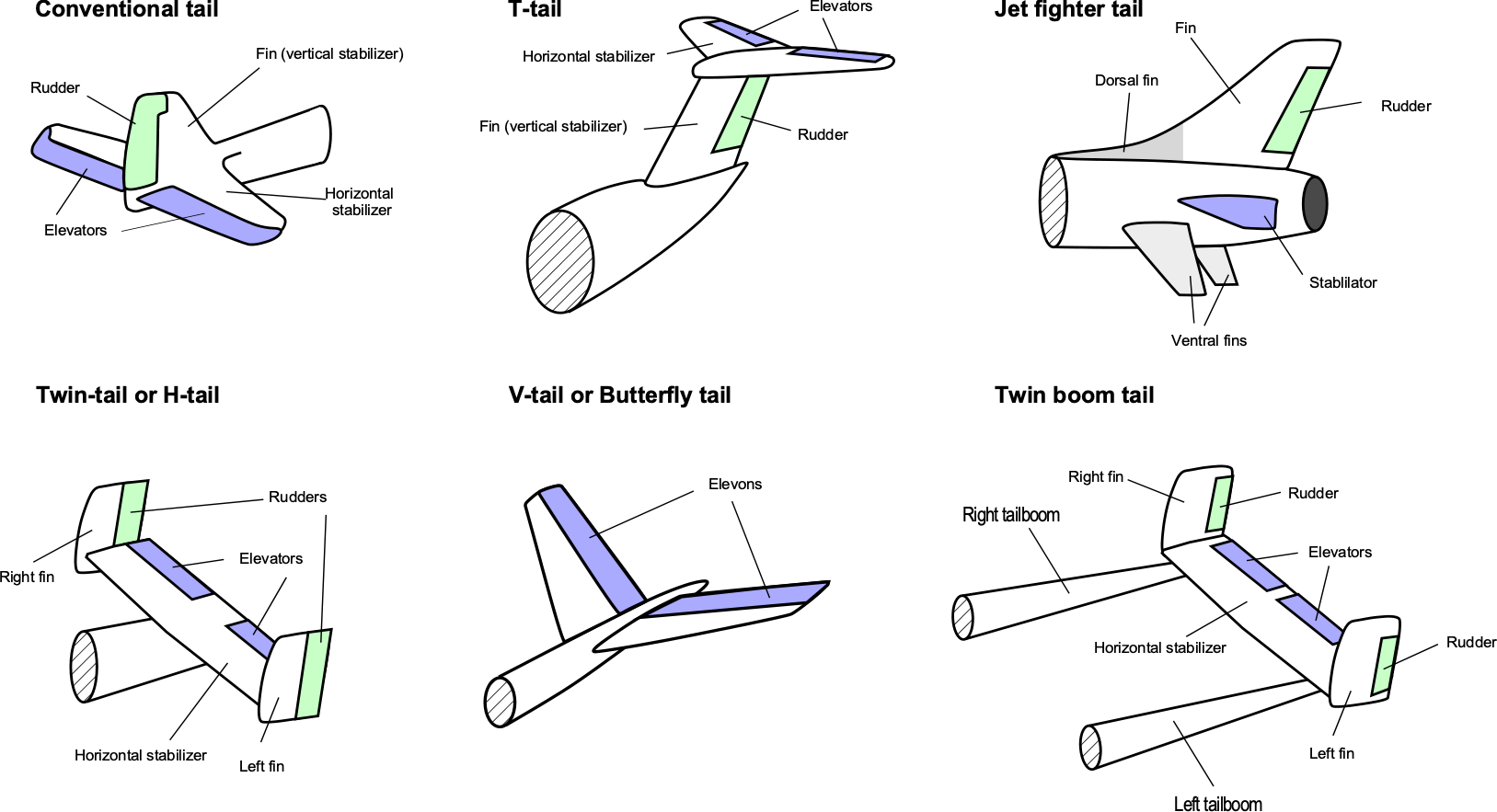
Each tail configuration has relative advantages and disadvantages, but in some cases, there may be a design preference for using one type of tail over the other. For example, the V-tail or butterfly tail has the advantage of only two lifting surfaces versus three, potentially saving weight and manufacturing costs. However, the response of the flight controls (e.g., the separate application of elevator and rudder) can become aerodynamically coupled (i.e., pitch, roll, and yaw are less clean and separate responses). To this end, an appropriately designed flight control system must be designed to decouple the responses.
A T-tail is out of the turbulent wake of the main wing, thereby improving its aerodynamic effectiveness for a given control deflection. However, this type of design is usually structurally heavier than the conventional tail. A T-tail design has also been shown to be more prone to flutter when attempts to reduce its weight have also led to reduced structural stiffness. The high torsional stiffness of the rear fuselage is also essential. Nevertheless, a T-tail configuration is common for modern airplane designs. Historically, the T-tail design also has some aerodynamic concerns, such as a susceptibility to “deep stall” at high angles of attack where the turbulent flow from the wing blankets the tail surfaces and reduces the effectiveness of the elevator and rudder, and must be thoroughly investigated during flight testing.
In the twin-boom tail or double-tail empennage design, the aft airframe consists of two separate fuselages or “tail booms,” each with a rudder but usually connected by a single horizontal stabilizer. Although the twin-boom empennage configuration is less common today, many aircraft have been designed with this type of empennage. It can be used when a conventional empennage is not possible. For example, when a propulsion system (propeller or jet) is installed at the rear of the fuselage, there can be significant flow interference between the propulsion system and the airframe, which can be minimized using a twin-boom tail. Specific cargo aircraft that require rear loading, or when there are aircraft length and/or height constraints constraints, may also use a twin-boom tail.
Engine Placement
Unless a glider, all airplanes have thrust-producing devices (i.e., engines or so-called powerplants) to sustain flight. The powerplant consists of the engine (and propeller) and related accessories such as electrical generators, hydraulic pumps, pneumatic pumps, oil pumps, fuel pumps, etc. The main engine types are the reciprocating (or piston) and reaction type engines such as the ramjet, pulsejet, turbojet, turboprop, and rocket engine.
The history of aircraft shows that various engine placements have been used. The preference for using one engine type or engine placement over another depends on many factors, including the airplane’s purpose. Below are examples of engine placement for propeller-driven airplanes.
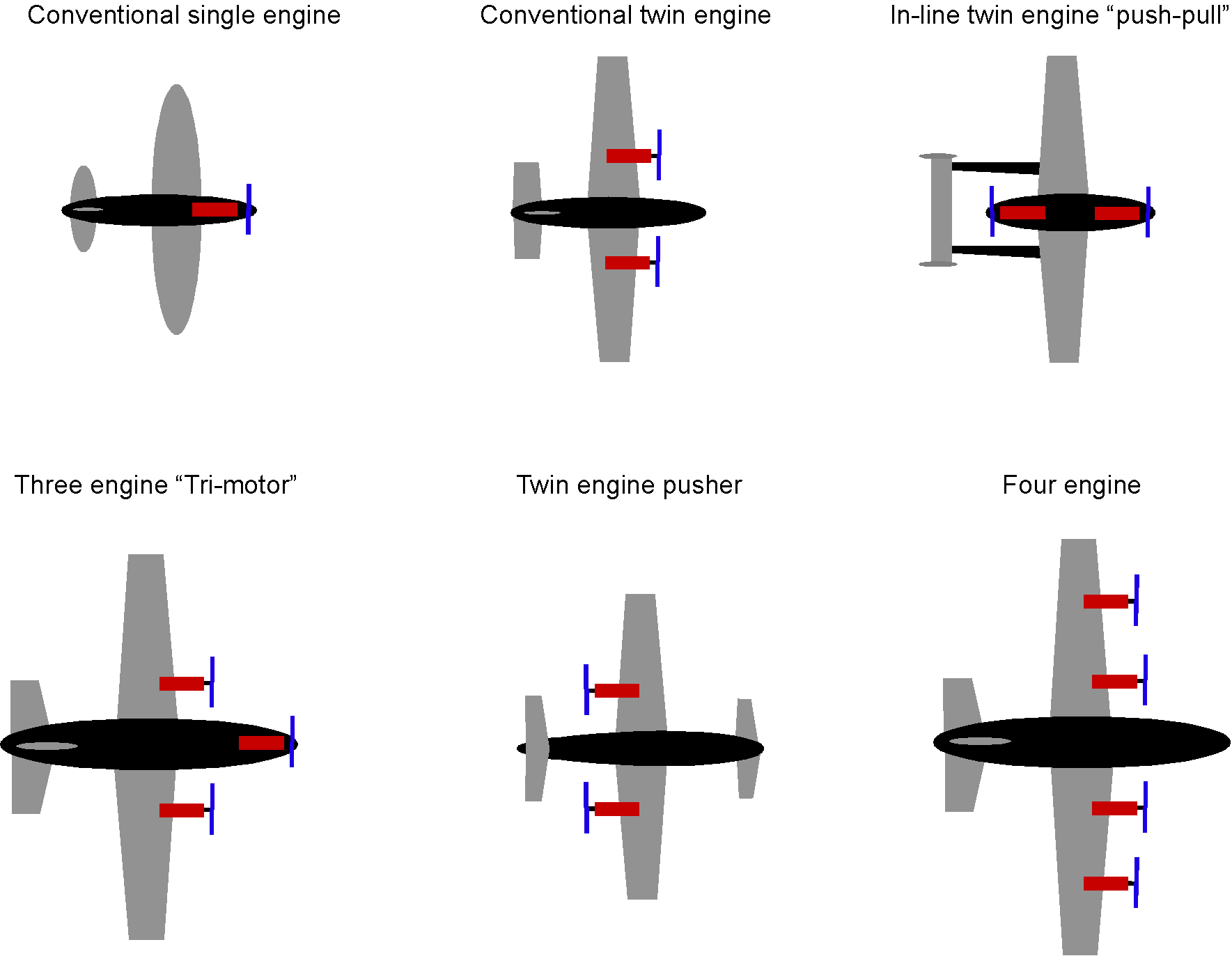
There are also many different engine placements for jet airplanes, as shown in the figure below. Wing-mounted underslung engines are the most common configuration for airliners, although rear-mounted engines are standard for smaller regional and business jets. Military fighter airplanes generally have engines installed inside the fuselage, reducing drag and giving better ballistic tolerance.

Undercarriage Designs
The undercarriage or landing gear supports the airplane’s weight while on the ground and absorbs landing loads. However, the landing gear is also subjected to high forces during landing, including vertical and sideward loads. Therefore, the landing gear assembly must be as light as possible, in addition to the needed strength. To this end, the landing gear must be made from materials such as steel, aluminum castings, or, in some cases, titanium. Titanium is lightweight and robust but is extremely expensive compared to steel and aluminum.
There are numerous undercarriage or landing gear designs. The most common is the tricycle gear, which has two main gear leg assemblies or “bogies” and a single steerable nose wheel. This design gives the airplane good directional stability on the ground. Larger airplanes may use two or more wheels on each landing gear leg, and the very largest airplanes may use three or four main gear legs, e.g., the Boeing 747, A380, etc.
Another typical design is the tailwheel undercarriage or “tail-dragger.” Tailwheel airplanes were used in the early days of aviation, so the tailwheel design has become known as conventional landing gear. In this design, the two main forward wheels will carry most of the airplane’s weight, and a smaller wheel is located at the tail. The conventional landing gear has the advantage of reduced weight, but this design is much less directionally stable when on the ground. Also, the pilot may have difficulty seeing ahead while taxiing on the ground. Nevertheless, the tailwheel undercarriage is relatively common, especially on smaller airplanes, because it is simple and lightweight. However, such a configuration would be unsuitable for larger commercial airliners.

The tricycle gear is the most prevalent landing gear configuration used in aviation. In addition to the main wheels, to aid with the potentially high impact of landing, most landing gear systems have a means of either absorbing shocks or accepting shocks, thereby distributing the loads so that the structure is not damaged. This is usually done with an oleo strut containing air and oil. The air in the strut is compressed under load, giving progressive stiffness, and the oil provides the damping. Wheels and tires are designed specifically for aviation use, with characteristics that include the ability to absorb high-impact loads and some side loads.
Smaller airplanes generally have a fixed landing gear that does not retract. This approach is a simple design with low weight but has higher aerodynamic drag. Sometimes, spats are used to cover and streamline the wheels. Larger and faster airplanes will inevitably have retractable landing gear, which is retracted into the fuselage and the wings after takeoff. While the retractable gear design significantly reduces drag, there is also a weight penalty as well as increased cost and maintenance requirements; usually, a hydraulic system is used to raise and lower the landing gear.
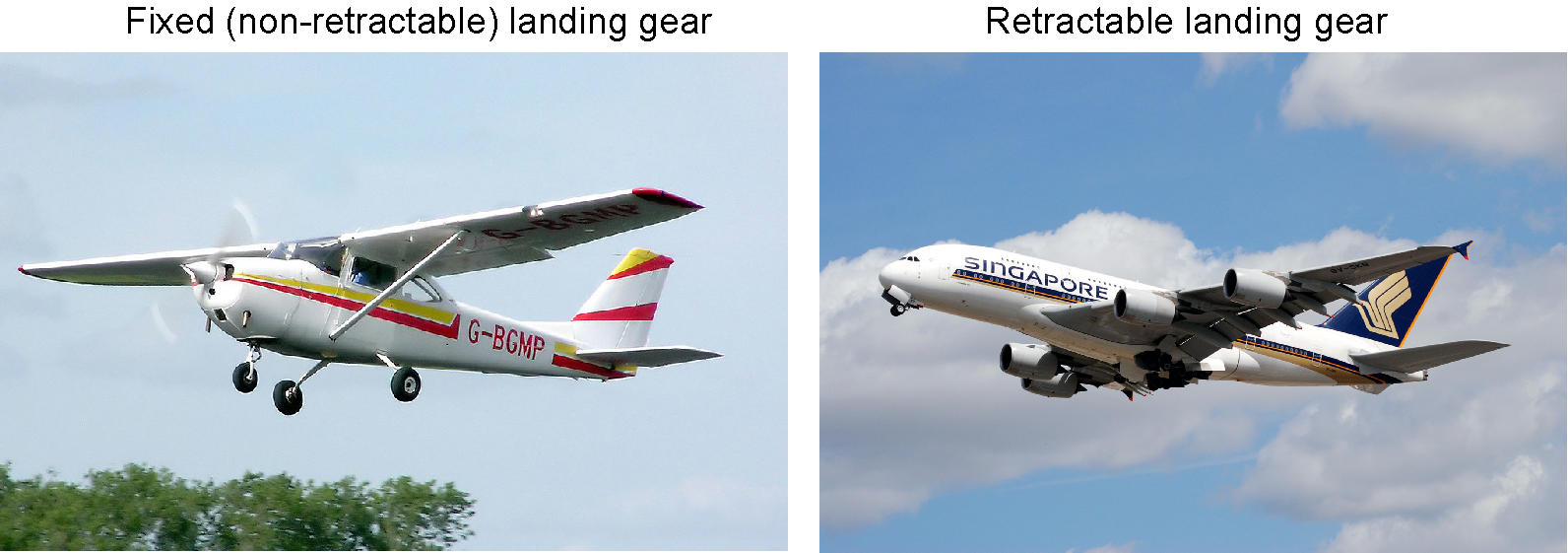
Not all aircraft have landing gear configured with wheels. Seaplanes are equipped with pontoons or floats for operation on water. A large amount of drag (shear force) is produced on this type of gear during water operations, but an aircraft operating from water can be very useful. Additional engineering requirements are imposed on seaplanes to ensure that the floatation components are not only airworthy but also seaworthy. In this regard, many additional tests on the water and in the air are needed to ensure the airplane is safe and exhibits acceptable handling qualities throughout its operational envelope. Skis are used on some aircraft for flight operations from snow and ice, increasing capabilities in parts of the world where cold weather may prevail for much of the year. Skids are a common landing gear configuration for helicopters, providing a lightweight, stable, and robust platform for flight operations. They are also designed to absorb the impact forces during landings. Depending on their intended use and operational environment, some helicopters use other landing gear configurations, such as wheels or floats.
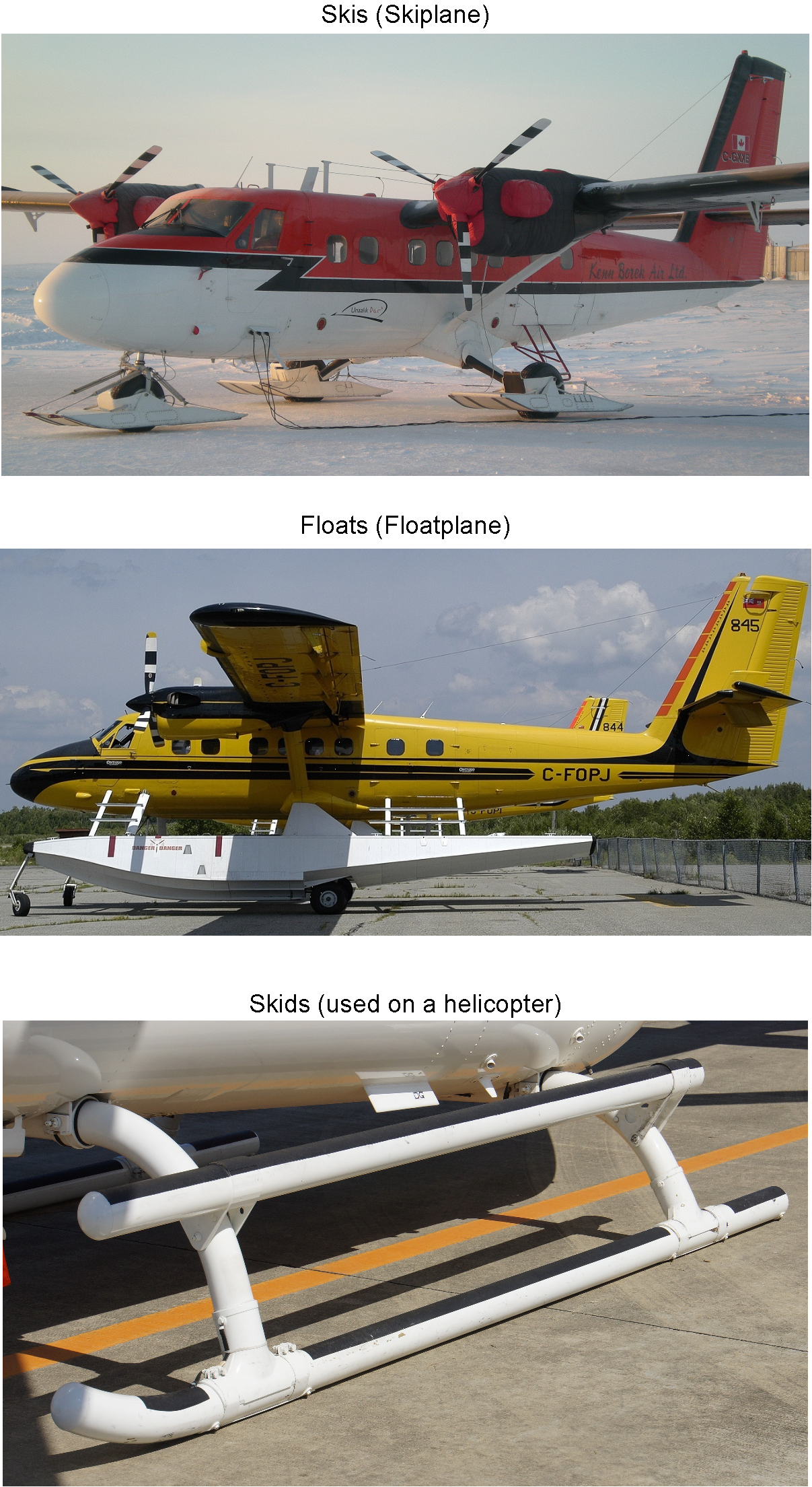
Anatomy of a Helicopter
A helicopter is a form of rotorcraft. An important advantage of the helicopter is that it can take off vertically from land or sea, hover motionless over a point, and fly in almost any direction. The main rotor provides the thrust to overcome the helicopter’s weight; changing the pitch of all the blades together modulates the rotor thrust. The main rotor is also used for control and forward propulsion, which is achieved by cyclically changing the angle of the blades and tilting the plane of rotation of the rotor disk. This approach alters the line of action of the rotor thrust vector, which provides aerodynamic forces and moments on the rotorcraft.
The tail rotor provides a side force and a moment to compensate for the torque reaction produced by driving the main rotor through a vertical shaft. Furthermore, by modulating the thrust of the tail rotor, which is done by changing the pitch of the blades through the pilot’s control inputs, directional (yaw) control is achieved.

However, despite all the helicopter’s advantages, it is a relatively low-speed aircraft with maximum cruise airspeeds of only 160 knots. It is also unable to fly very far, with flight ranges of less than 500 miles, depending on the payload being carried. The limitations of the conventional helicopter have prompted the development of hybrid concepts such as the tiltrotor, e.g., the V-22 Osprey, which has some of the advantages of the helicopter (i.e., a vertical takeoff and landing capability) and the airplane (i.e., able to fly faster and further).
Anatomy of an Airship
An airship is a type of aircraft that uses buoyancy to stay aloft. It is characterized by its large, helium-filled envelope and can be steered and controlled. It is important to note that airship designs can vary significantly and include rigid airships with an internal structure called dirigibles or non-rigid airships, called blimps. An example of a blimp is shown in the schematic below.

The envelope is the outermost part of the airship and is typically a large gasbag filled with helium; the helium provides the buoyancy necessary to keep the airship aloft. The envelope is usually made of lightweight, non-porous, and highly durable materials like nylon or polyester. Below the gas envelope hangs the gondola, which accommodates the crew and passengers. The gondola also contains the cockpit, control systems, propulsion mechanisms, and navigation equipment. Airships are typically powered by one or more engines attached to the gondola or mounted externally. These engines drive propellers or fans to provide forward thrust to propel the airship through the air.
The ballonets are internal air ballast tanks within the gas envelope. They help regulate the airship’s buoyancy by controlling the relative weight of air to helium; air is about eight times as heavy as helium. By pumping air into or out of the ballonets, the pilot can control the altitude and pitch attitude of the airship. Airships also have aerodynamic control surfaces to maneuver and maintain stability during flight, and these function just like an airplane. The vertical and horizontal tails give the airship directional stability. The rudder controls yaw, and the elevator helps control pitch attitude, although the differential ballast in the ballonets gives primary pitch control for takeoff and landing.
Anatomy of Spacecraft
It is much more difficult to define or classify a rocket or spacecraft in a manner done for aircraft because there are no officially designated categories or classes of spacecraft. The size, shape, and arrangement of the components of a spacecraft tend to be very mission-specific, so many different types of spacecraft have been built and flown over the years.
The name “spacecraft” refers to launch vehicles, satellites, or anything else intended to leave Earth’s atmosphere. Some launchers are reconfigurable in that they can be built with different stages or optional solid rocket boosters, depending on the mission and the payload. For example, a payload launch to high Earth orbit may require a different booster stage rocket than one that has to go into low orbits. However, spacecraft have one thing in common: they are all designed to operate at and beyond the limits of the Earth’s atmosphere in space, and so must be powered by rocket engines or, at the very least, have used rocket engines to get into space.
With a multi-stage launcher, a satellite or other payload will be housed in a fairing at the top of the launch vehicle. The stages are two or three rocket-powered launchers stacked on each other; these components are called the launch vehicle. A schematic of a three-stage launch vehicle, the Saturn V, is shown below.
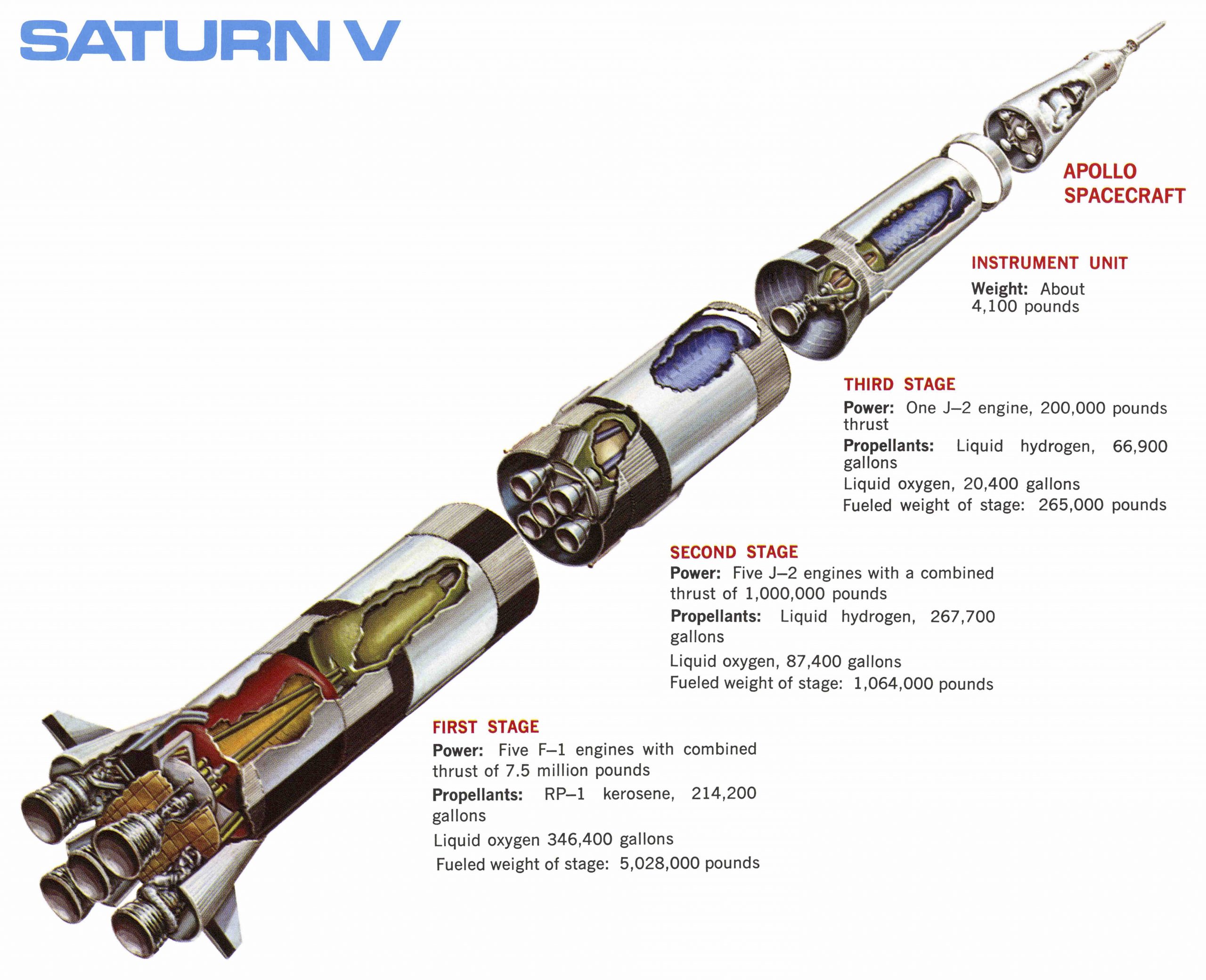
The first stage is used for the initial part of the launch until its fuel is expended, and then this stage is jettisoned. The second stage then takes over and propels the vehicle to a much higher altitude, and this second stage is also jettisoned after its fuel is exhausted. Next, the third stage takes over and rapidly accelerates the payload to its orbital velocity. Finally, the third stage may be jettisoned as the payload reaches its required orbital altitude.
The advantage of launching the satellite with a multi-stage rocket in a staging process is that it reaches a higher final velocity because the mass (weight) of the rocket is substantially reduced after each stage is depleted of fuel and jettisoned, so less total propellant is needed. The ultimate engineering goal of staging is to maximize the payload ratio, meaning the largest amount of payload is carried up to the required burnout velocity using the least non-payload weight (i.e., the empty weight of the rocket structure plus its propellant).
Rockets with two stages may launch payloads that must go into low Earth orbit. However, three stages may be required for payloads that must reach higher altitudes or deep space. For example, multi-stage boosters are always needed to reach geostationary or geosynchronous orbits.
Very high propellant flow rates through a rocket engine are needed to create the necessary thrust from the nozzle exit. Upstream combustion chambers drive turbopumps to supply and regulate the fuel and oxidizer’s required flow rates. The fuel is circulated in chambers around the nozzle to keep it cool and pre-heat it, which is called regenerative cooling. Pre-heating the fuel also increases the final combustion efficiency and the rocket’s net thrust.
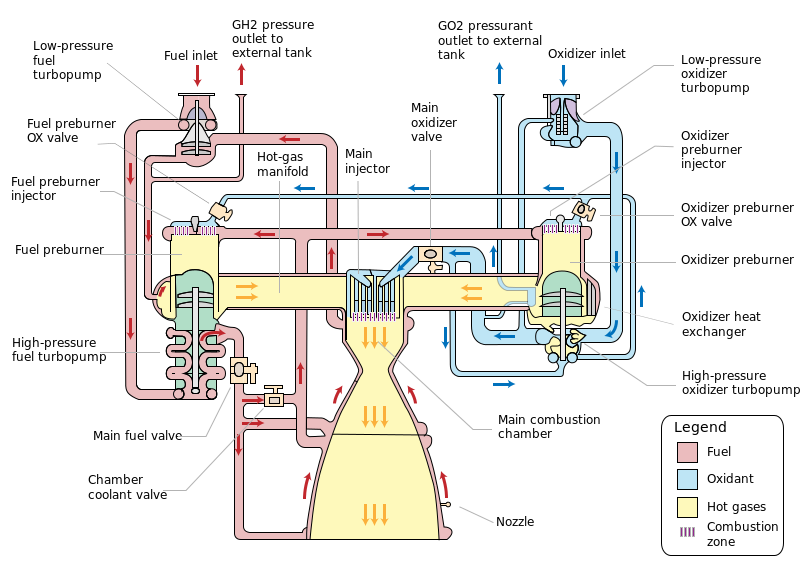
Another advantage of staging a launch booster is that each stage can use a different type of rocket engine tuned for its particular operating conditions. For example, the first-stage engines are optimized for use in the atmosphere. In contrast, the last stage can use engines suited more to space conditions, i.e., for operations in a vacuum. Furthermore, different fuels may (and often will) be used for the different rocket engines.
A significant disadvantage of multi-stage launch vehicles is that the stages and their engines are lost because they burn up from kinetic heating as they re-enter the Earth’s atmosphere. Reusable launch vehicles are becoming more feasible, the initial stage (or stages) being candidates for recovery, refurbishment, and reuse. Solid rocket boosters are often lost, but sometimes, if they are jettisoned at lower altitudes, they can be recovered using parachutes and refurbished.
Solid rocket boosters can increase payload capability or augment launch speeds to reach higher orbital velocities and altitudes. This approach allows a primary launch vehicle more flexibility to be configured to the specific mission. While attaching a cluster of solid rocket boosters is sometimes considered inelegant, it is convenient (for reconfigurability) and relatively low cost.

The commercial launch company SpaceX has been routinely recovering the first stage of their Falcon rocket, being steered back to the launch pad (or to an offshore barge) to make a vertical landing. Over the past few years, SpaceX has made many successful recoveries of its Falcon 9 rockets.
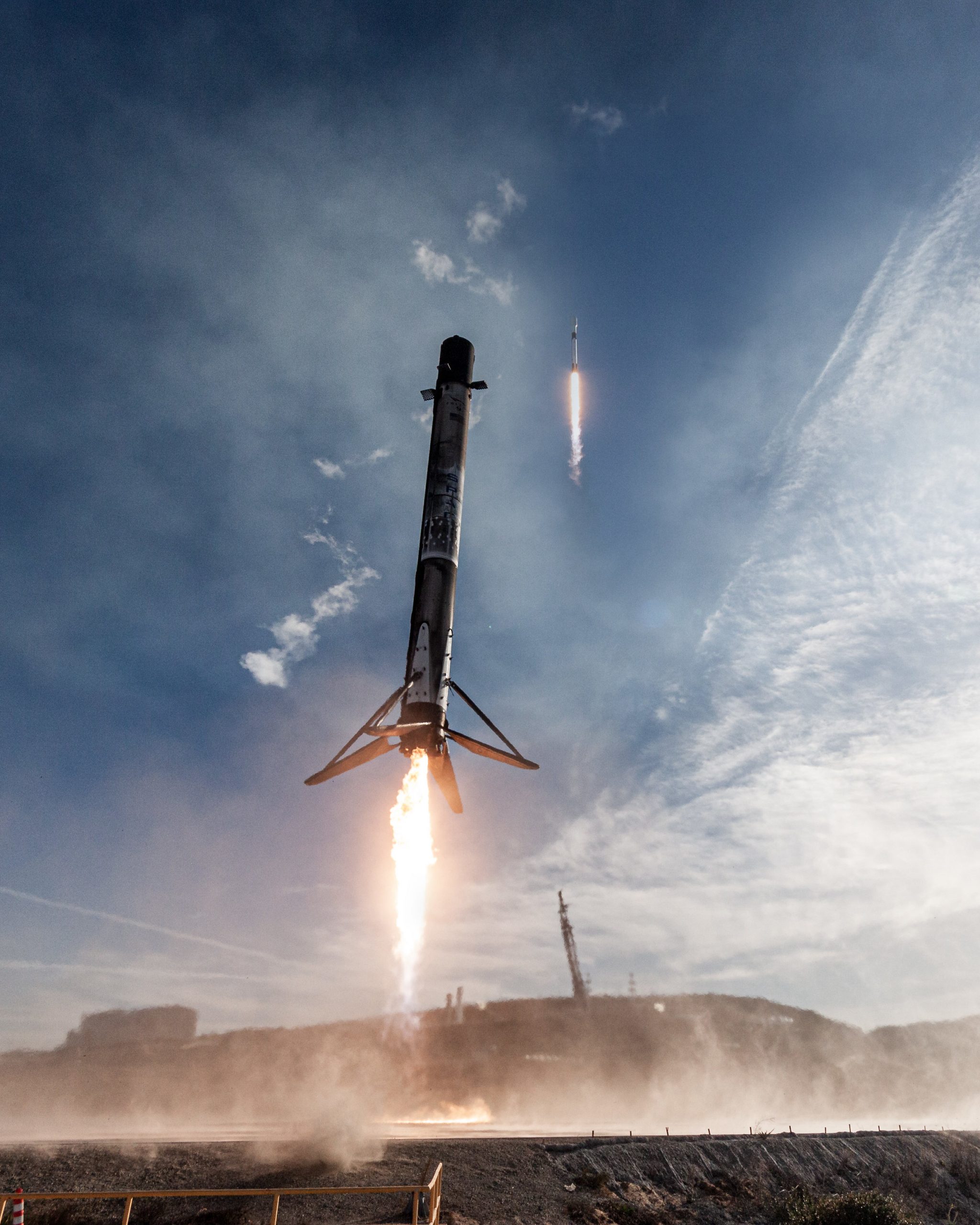
However, to accomplish this impressive feat, ample fuel must be carried on the first stage in excess of the fuel needed to launch the payload. Also, aerodynamic flight control surfaces and cold-jet attitude thrusters must be added to the first stage to help steer it along the required trajectory to the landing point. Finally, retro-braking is performed by reigniting one or more of the main rocket engines. There are unique challenges in achieving this incredible feat of flight dynamics and control.
The ability to reuse rockets, such as the first-stage booster and its engines, is critical to making space launches more affordable. Launch vehicles can cost hundreds of millions of dollars, and reusing a first-stage booster, for example, can cut tens of millions of dollars off the cost of a launch to a customer. Now retired from service, the Space Shuttle concept was the best example of a mostly reusable spacecraft. The heart of the concept, the Orbiter, was partly a spacecraft and partly an aircraft designed to re-enter the atmosphere after the mission and glide to a landing on a runway, albeit a very long one.
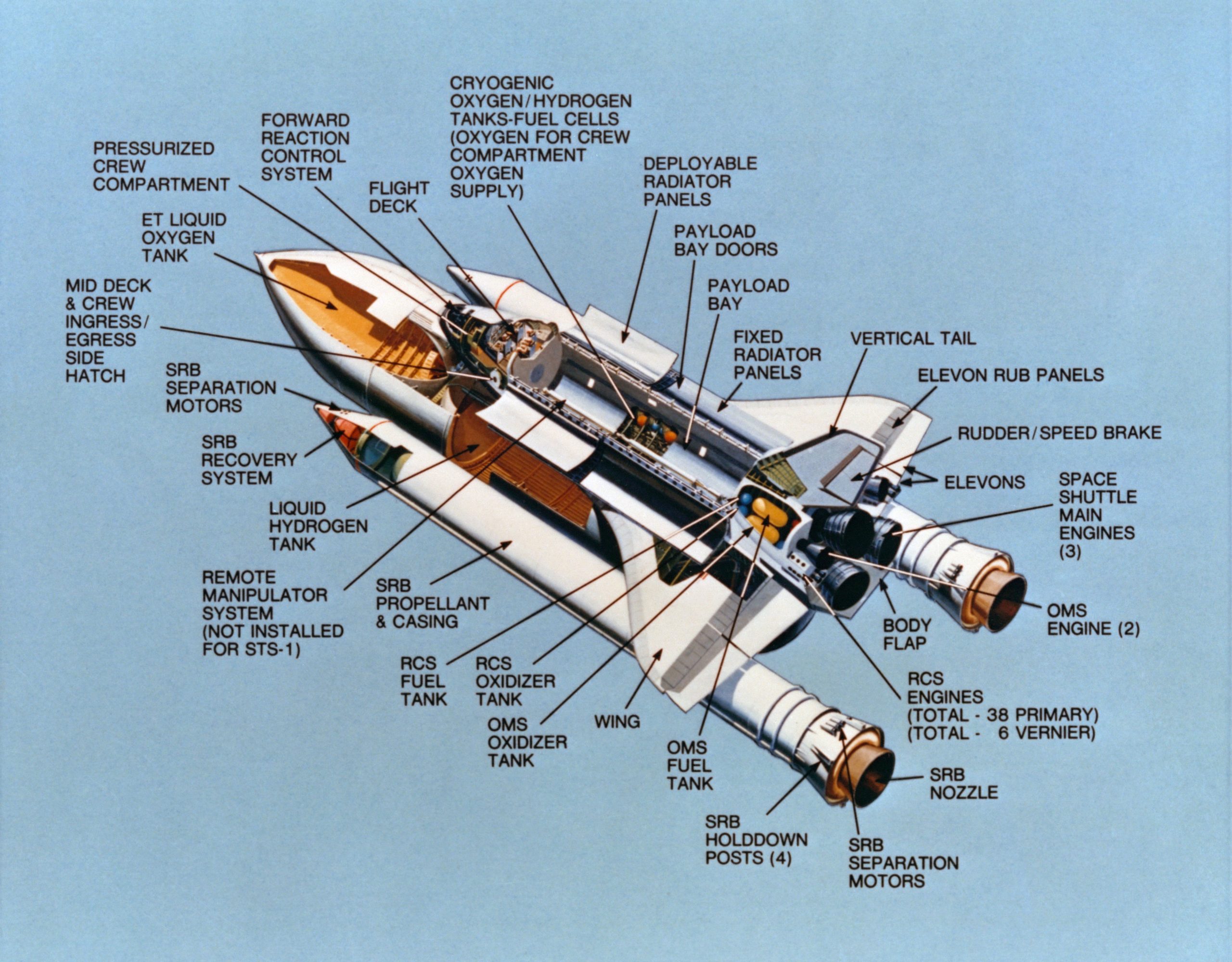
The Orbiter was powered by three extremely powerful rocket engines, which were only used during launch. The propellant for these rockets (liquid hydrogen LH2 and liquid oxygen LOX) was stored in the large external tank, which was jettisoned as the vehicle reached orbit, and the tank then burned up in the atmosphere. The two solid rocket boosters, or SRBs, burned for just two minutes into the launch, and when their fuel was exhausted, they were jettisoned and parachuted into the ocean. The payload for the mission was contained entirely within the Orbiter, which allowed it to be deployed into space. Other things could also be captured and carried back to Earth, which was an extremely useful feature when servicing the space station.
The payloads launched by rockets may comprise satellites, deep-space probes, interplanetary probes, telescopes, provisions for a space station, crewed capsules, or almost anything else. For example, the image below shows details of the Voyager deep space probe, which has several different instruments and communication antennas. Satellites and spacecraft also have solar panels to provide the electrical power needed for their systems. Remember that there is no air in space to cause any drag, so aerodynamics is not a consideration, and the spacecraft can be almost any shape. Nevertheless, its mass distribution is still crucial because the inertial characteristics of the spacecraft about all three axes are essential for guidance and control purposes.
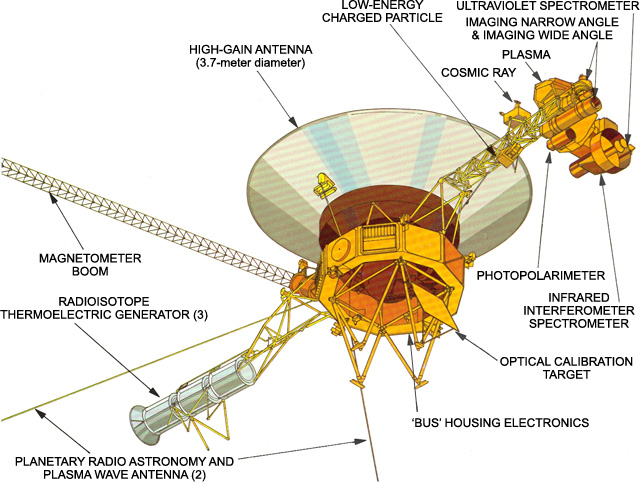
Since it was launched into low Earth orbit by the Space Shuttle, the Hubble Space Telescope (HST) has provided astronomers with a much more detailed understanding of our solar system and beyond. A cutaway of the HST is shown in the figure below. The forward part of the HST houses the main optical assembly. The center part of the telescope houses the control electronics. Finally, the aft part houses all of the instruments and sensor electronics. The solar panels provide the needed power.

Summary & Closure
Aircraft and spacecraft are each uniquely designed to perform specific functions and meet certain operational requirements. In this regard, aircraft and spacecraft will have different anatomies tailored to their respective missions. Airplanes have a fuselage housing the cockpit and space for the payload (passengers and cargo), wings for generating lift, empennage for stability and control, engines for propulsion, and landing gear for takeoff and landing. In contrast, spacecraft are characterized by specific design anatomy to fulfill a specialized mission. This anatomy may have a service module containing propulsion and power systems, a command module housing computers and communication equipment, solar panels for power generation, and thermal protection systems. All types of flight vehicles are intricately designed with considerations for aerodynamics, structural integrity, and mission requirements. However, aircraft are optimized for atmospheric flight, while spacecraft are tailored for operation in the vacuum of space.
5-Question Self-Assessment Quickquiz
For Further Thought or Discussion
- Research unusual types of airplanes that may not conform to the “normal” airplane configurations discussed in this chapter.
- It has been proposed that future airliners may not have passenger windows. Why? Discuss.
- Why do birds not have vertical tails?
- Research the purpose of using “stagger” on a biplane configuration.
- Discuss a flying wing’s relative advantages and disadvantages over a conventional airplane configuration.
- Discuss the potential relative engineering risks associated with a reusable rocket booster stage.
- Why is a helicopter a “low-speed” aircraft? Do some research to find out the factors that may limit the forward speed of a helicopter.
- What might be the relative advantages of a tiltrotor aircraft compared to a helicopter and an airplane?
Other Useful Online Resources
To learn more about the anatomy of aircraft and spacecraft, try some of these online resources:
- Airplane parts and functions tutorial by NASA – see here.
- For more information about aircraft anatomy, including differences between early and modern airplanes, explore the National Air & Space Museum website here.
- Video on building an Airbus A-350.
- Great graphics showing the internal structure of a jet airliner.
- This great video shows the ailerons, flaps, and spoilers on a Boeing 777.
- Video of the landing gear operation on a Boeing 767.
- Take a tour of the Roll-Royce jet engine factory.
- Test your understanding of the parts of a rocket here.
- Have you ever wondered how to start a rocket engine?
- Aircraft anatomy quizlet.
- The worst-looking rockets ever designed!
- Why a rocket launch requires millions of gallons of water!
- See here for some great details about the anatomy of the Orion crew module.
- A look at how SpaceX achieves astonishing landing accuracy with the Falcon 9 rocket.

